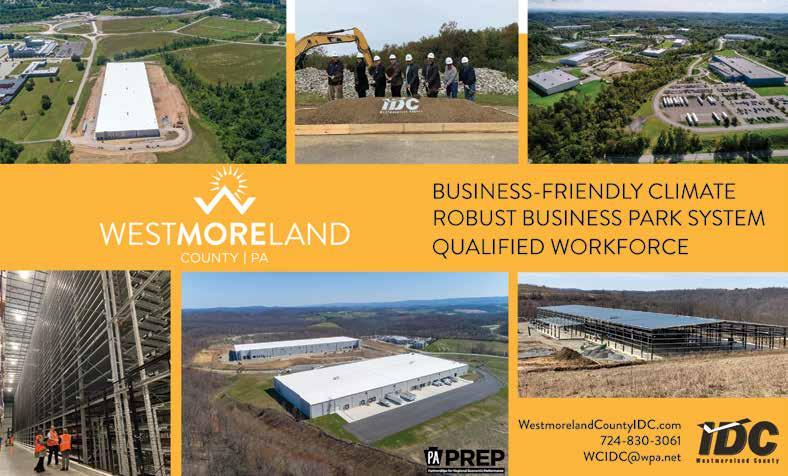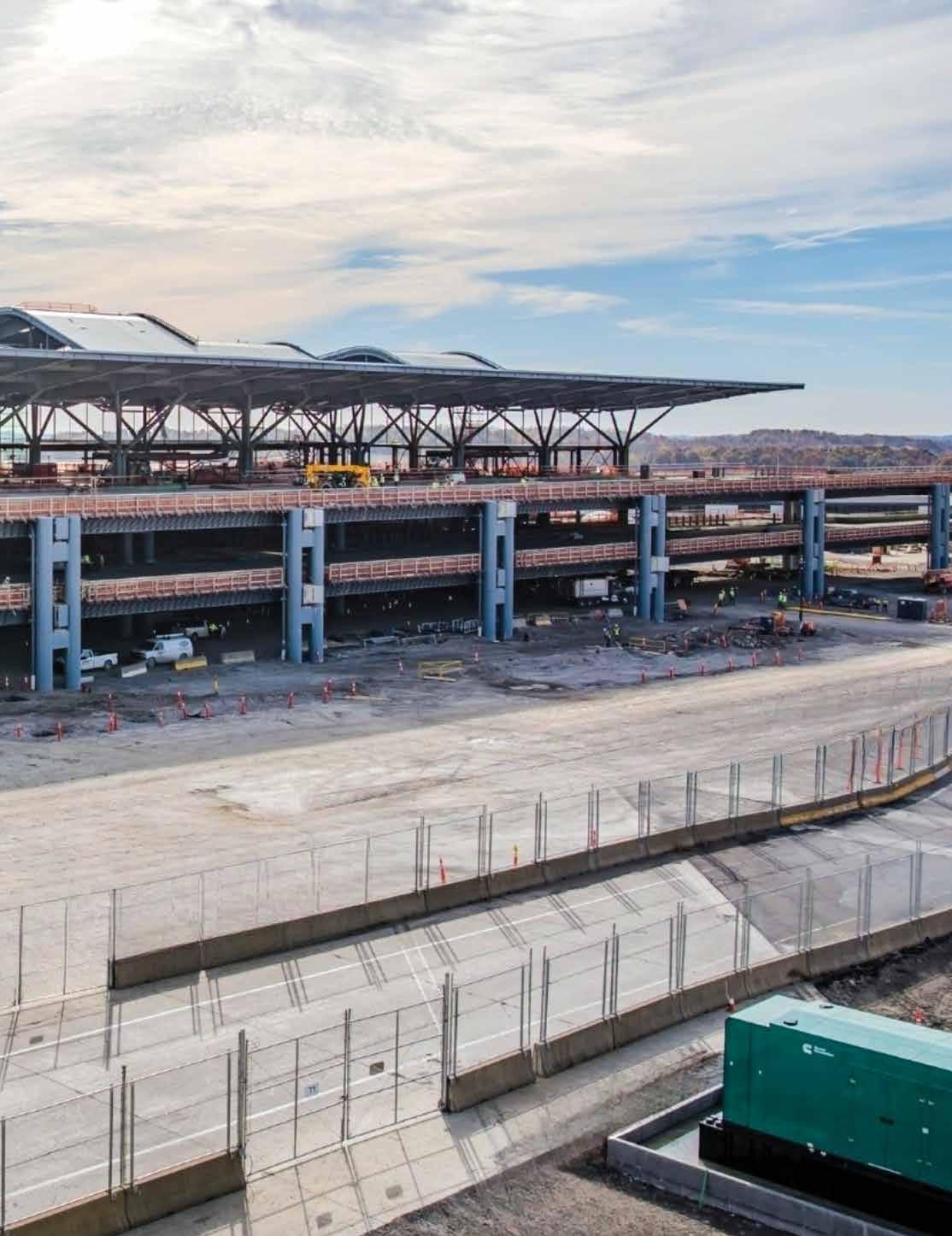

THE BIG PICTURE: IMPACT OF THE NEW AIRPORT

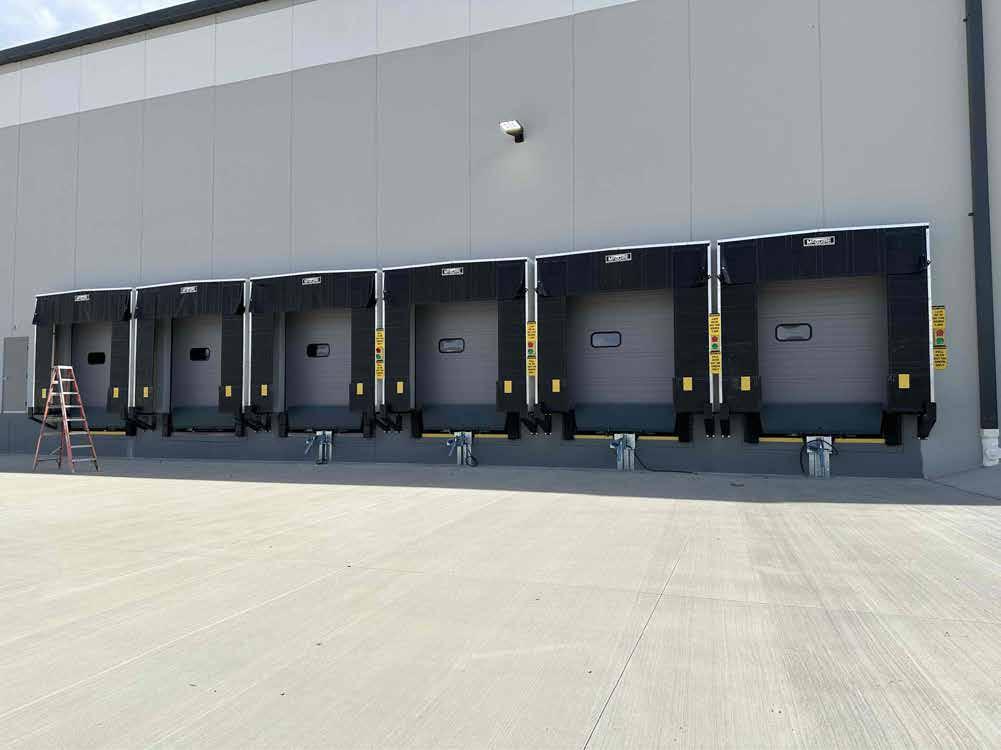
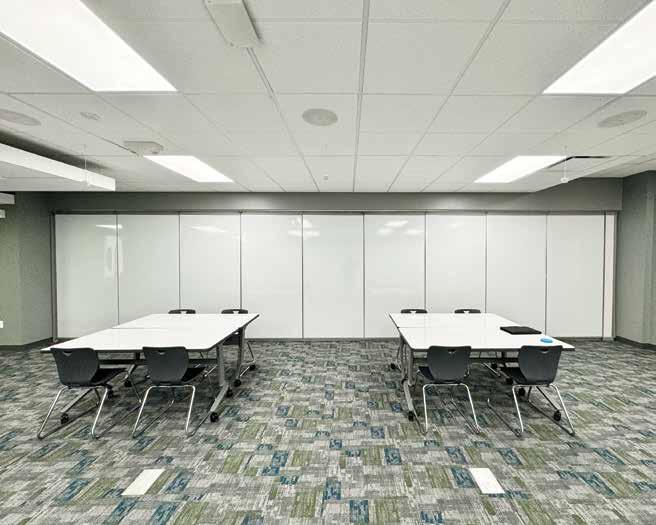
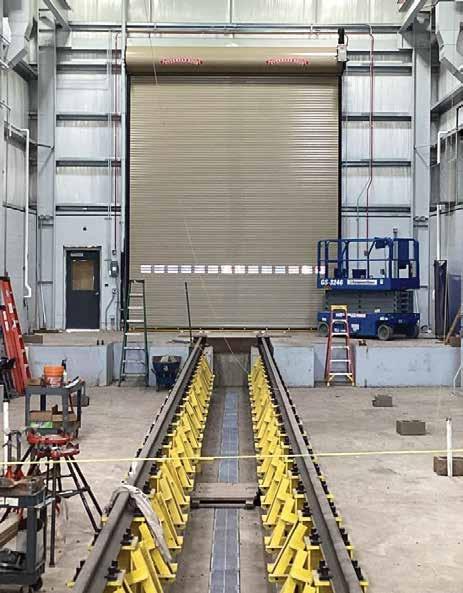
LET’S MAKE HISTORY


Since 1979, PJ Dick has been constructing the future one project at a time. Our legacy has created a long list of historic buildings and infrastructure throughout the Mid-Atlantic region.
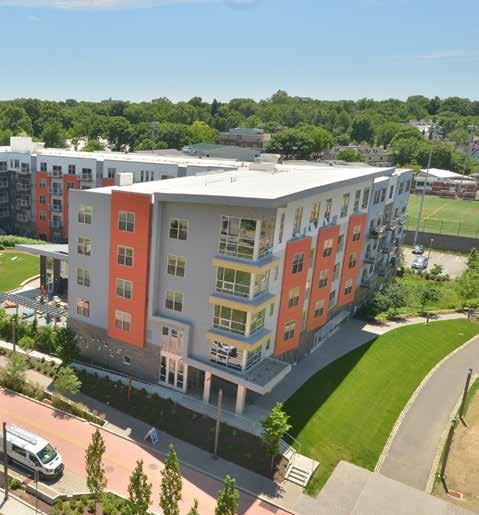
We bring our heritage of dependable construction with an eye towards growing the future. Because when you work with PJ Dick, you’re building with the future — and the past — in mind.
Partner with PJ Dick for construction projects in:
Healthcare | Higher Education | Sports & Entertainment | Multi-family | Commercial Space Mixed Use | Transportation Infrastructure
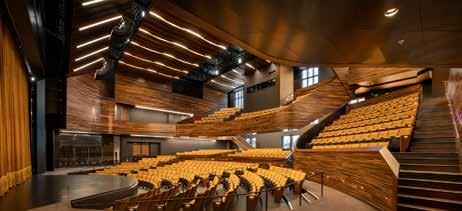

Scan the QR Code to check out our website!
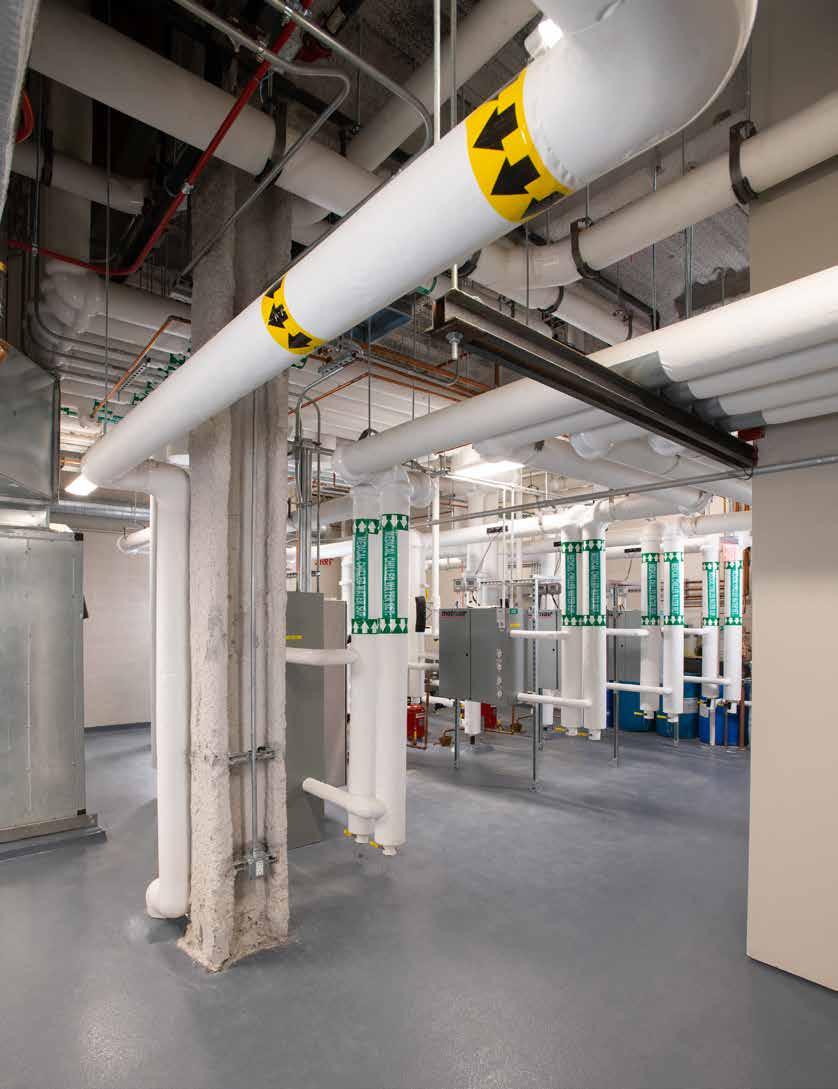


PUBLISHER
Tall Timber Group www.talltimbergroup.com
EDITOR
Jeff Burd 412-366-1857
jburd@talltimbergroup.com
PRODUCTION
Carson Publishing, Inc.
Kevin J. Gordon
ART DIRECTOR
Carson Publishing, Inc.
GRAPHIC
CONTRIBUTING PHOTOGRAPHY FlyPittsburgh Independence Excavating Inc.
Mascaro Construction LP Master Builders’ Association NAIOP Pittsburgh PJ Dick Inc. Roy Engelbrecht Photography
ADVERTISING DIRECTOR
Karen Kukish 412-837-6971 kkukish@talltimbergroup.com
MORE INFORMATION:
BreakingGroundTM is published by Tall Timber Group for the Master Builders’ Association of Western Pennsylvania, 412-922-3912 or www.mbawpa.org
Archive copies of BreakingGroundTM can be viewed at www.mbawpa.org
No part of this magazine may be reproduced without written permission by the Publisher. All rights reserved.
This information is carefully gathered and compiled in such a manner as to ensure maximum accuracy. We cannot, and do not, guarantee either the correctness of all information furnished nor the complete absence of errors and omissions. Hence, responsibility for same neither can be, nor is, assumed.
Keep up with regional construction and real estate events at www.buildingpittsburgh.com
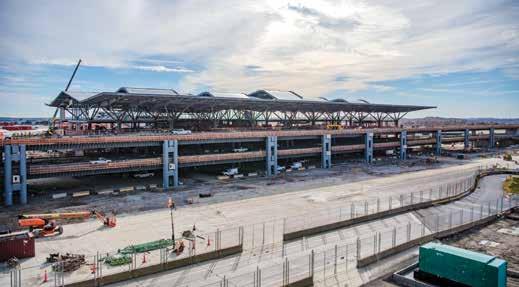
On the cover: Terminal Modernization Program at Pittsburgh International Airport. Photo by FlyPittsburgh.














PUBLISHER’S NOTE
On page 49 of this edition, in the Trend to Watch column, you’ll find an interesting article that highlights the research of Ken Zapinski, director of research and public policy for Pittsburgh Works Together. Ken dug into the population data for Pittsburgh to uncover some interesting and mostly unpublicized trends. The gist of it is we are attracting more new people to the region than you think, just not enough to offset the number who are dying.
At the conclusion of the article, almost in passing, Ken recommends a book to our civic leaders, Shrinking Cities in a Shrinking World: Learning to Thrive Without Growth, by Alan Mallach. It was the second reference to thriving without growth that had been brought to my attention recently. John Ryan, principal at Design Group and 2023 AIA Pittsburgh president, had asked me about that when I spoke to the AIA Pittsburgh board in early December.
In all candor, I had not given much thought to the merits of the growth mindset versus the thriving mindset prior to this month. The two seemed to be two sides of the same coin. As you might imagine from the book’s title, however, Mr. Mallach is of the opinion that cities can thrive without growth. Ken recommends that Pittsburgh’s leaders consider that mindset in light of our demographic challenges.
I am not quite ready to give up the pursuit of new residents to Western PA. Having been raised elsewhere and having lived and worked in Charlotte, Atlanta, and Dallas during the 1980s, I see Pittsburgh as a place everyone should want to live. And the evidence of my eyes correlates with Ken’s research. The face of Pittsburgh is much younger than it was 20 years ago. We still have a lot of old people in this region, but if we keep trading a young new resident for every retiree who moves south or dies, Pittsburgh will be much younger in 20 years. It will not have grown, however, and there is a downside to that, especially when it comes to economic development and business attraction.
The question to explore is, how bad would that really be?
The Chamber of Commerce answer is that it would be bad. It is a logical answer. If there are more people, businesses can add workers. More people with jobs means more shoppers for stores, more diners for restaurants, more tax revenues for reinvestment in roads, schools, parks, and other public benefits. It feels good to have more people wanting to move to your town. They are validating your decision to live there. When people leave to find work elsewhere, the reverse is true.
I don’t think I am going to change my opinion that population attraction is Pittsburgh’s number one priority; however, Mallach’s thesis does not appear to be that we should strive
to decline, but rather that we can thrive in an environment where growth isn’t occurring. I took that away from Ken’s article too, especially considering his finding that Pittsburgh is getting younger, even if the number of people living here is not growing.
When John Ryan asked me about this, I assumed he was asking my opinion about the wisdom of adapting policy to a non-growth mindset. I demurred since I had given it little or no thought. I did suggest that such a change in mindset would change how public funding incentives would be awarded.
Such a change in focus does not need to mean doom and gloom for construction and development. For example, if resources were not being used to chase growth would there be more available to help office building landlords deal with post-pandemic work life? There might be more resources available to be even more proactive about revitalizing Downtown. There would be opportunities to create incentives for residential developers to create more lots for new construction in places that weren’t Downtown, or to renovate dilapidated homes in older neighborhoods.
On the other hand, you could make the argument that Pittsburgh and its construction and real estate industries have been thriving without growth for a while now. Our population may have been stagnant or declining since 2000, but we have still managed to add more than 75,000 new single-family homes in that time. Commercial/nonresidential construction has settled in at the $4 billion dollar per year level, which has supported full employment for construction workers for nearly a decade. New developers, contractors, architects, and engineers have come to town and made a place for themselves without forcing competitors out of business.
Maybe Pittsburgh’s version of thriving is not as breathtaking as Nashville’s or Austin’s, but it is not a zero-sum economy either. Given the generational upheaval that took place in the 1980s, Pittsburgh is doing well. It took patience and perseverance. Those same qualities will eventually get us through this demographic valley. I would still rather see a new factory come to town or Gecko Robotics, or its ilk, hire 500 new engineers. In between those announcements, let’s keep thriving.
LABOR & BUSINESS
Allies for Economic Growth

REGIONAL MARKET UPDATE
SPONSORED BY:

Pittsburgh’s economy showed resilience throughout 2023, adding employment above the long-term trend despite a declining workforce; however, the combination of higher borrowing and construction costs chilled private development, keeping the volume of construction below the level that was anticipated.
Since the early recovery from the Great Recession in 2011, the economy in Western PA has been more resistant to the macroeconomic headwinds than most other regions. Although it lacks some of the principal advantages of southern and western U.S. cities, Pittsburgh has been a steadier region for employment because of the diversification of the industries that drive the local economy. Those industry sectors remain solid, with stronger prospects for the future.
The most recent edition of the Southwestern Pennsylvania Quarterly Vitals Report (Q3 July – September 2023), produced by the Pennsylvania Economy League of Greater Pittsburgh, summarizes the region’s employment picture. Compared to the overall U.S. economy, Pittsburgh has seen unemployment decline at a faster rate, while job creation has been muted by the decline in labor force. Employers added 17,000 jobs in Pittsburgh, year-over-year, through September 30. That was a 1.5 percent increase during a period when the workforce declined by 1.0 percent. In contrast, the U.S. payroll employment grew by 2.0 percent from September 2022 to September 2023, which matched the labor force expansion.
There were roughly 1.6 job openings for each unemployed person in metropolitan Pittsburgh, approximately the same ratio as the overall U.S. workforce. The number of open job listings in Pittsburgh fell by 18 percent from September 2022 to September 2023, again matching the decline nationwide.
Unemployment in metropolitan Pittsburgh fell below the U.S. and statewide rates during the third quarter. At 3.5 percent, the local unemployment rate is lower than at any period since metro level tracking began in January 1976. With workforce participation expected to remain stagnant or fall
slightly, unemployment in Pittsburgh will stay low in 2024. Moreover, several of Pittsburgh’s more dynamic employment centers have already experienced cutbacks ahead of 2024. Low unemployment is a bulwark against recession, even if consumer and business investment slow in response to uncertainty. Low unemployment also boosts household formations, a key driver of demand for housing.
Demand for housing will not abate in 2024 without a jarring economic event. Based upon the household formation trends since 2000, approximately 19,000 new households were formed in Western PA during 2023. Fewer than 1,000 new apartment units were built, and the number of new single-family units built fell by two percent to approximately 2,800 units. According to realtor.com, there were 4,358 existing single-family homes for sale at the end of October 2023, a decline of nearly 6,000 compared to the same month in 2016. Neither the current inventory of homes for sale nor rent is sufficient to meet the demand from new household formations.
The supply/demand imbalance should support the new development of most of the 8,000-plus multi-family units that have been entitled or approved in metropolitan Pittsburgh for the next few years. If interest rates retrace in 2024-2025, which will bring value calculations back towards agreement and make financing feasible again, the market would welcome construction of 2,500 new units annually through 2025.
The backlog of all types of projects in the pipeline has increased throughout 2023, even as an unexpected share of the 2023 pipeline was deferred. While final data on contracting and construction starts was not yet available, the slowdown in activity during the third quarter looked likely to trim 10 percent from the expected $4.8 billion in commercial/ nonresidential activity.

Demand for commercial, institutional, and residential structures has not cooled significantly in Western PA; therefore, the outlook for 2024 should not vary dramatically from 2023. That is not to say all sectors are experiencing strong demand. The office market is challenged by lower occupancy. Healthcare providers are struggling with higher costs, flat revenues, and staffing shortages. Colleges and universities are also seeing expenses grow as enrollment begins a cyclical decline. Nevertheless, there are enough bright spots, even in these troubled sectors, that more projects have been proposed to meet the growing demand.
Data current as of November 6, 2023. The Unemployment Rate reflects the nonseasonally adjusted rate. Source: Southwestern Pennsylvania Quarterly Vitals Report Bureau of Labor Statistics, Local Area Unemployment Statistics, Current Population Survey; Lightcast (datarun 2023.3)
A sector that has been troubled for almost a decade, the energy sector, has seen several

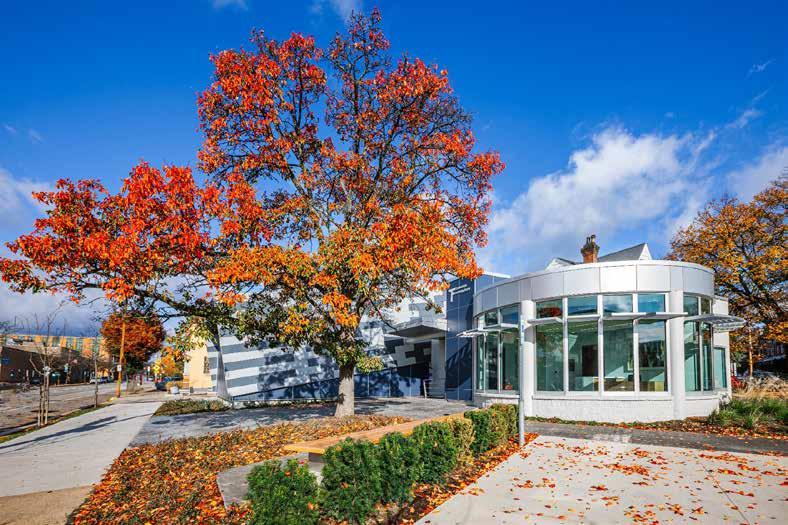
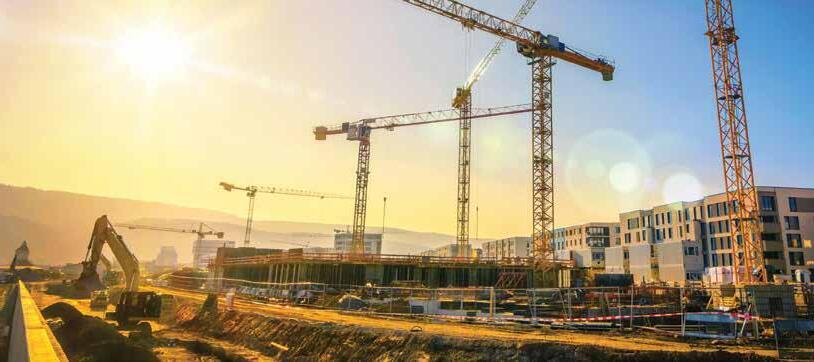
Photograph: Tomayko Gallery
Photography by Mike Christ
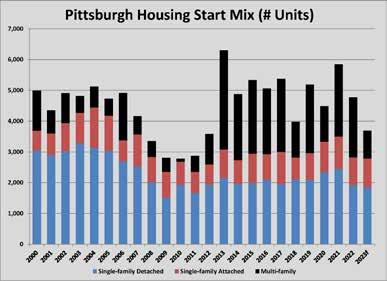
recent developments that suggest a strong uptick in demand. Industrial landlords report that several hundred thousand square feet of new leases have been signed this year for companies serving the natural gas industry. EQT CEO Toby Rice announced a proposal to significantly increase natural gas production in the Marcellus shale formation to grow liquid natural gas exports for the U.S. And Westinghouse reported several new sales or memoranda of understanding for its newer generations of AP-1000, AP-3000, and eVinci reactors. These sales are in addition to Westinghouse’s leasing of 87,000 square feet at 51 Bridge Street in Etna as a research facility for the eVinci microreactor.
Both the EQT and Westinghouse announcements are measures aimed at combating the renewed growth of global coal consumption using conventional energy sources, rather than renewable energy sources like wind and solar. While the share of renewable energy has grown, especially with the increased federal incentives included in the Inflation Reduction Act, global energy usage has increased at a more rapid rate. That has created an opportunity for natural gas and nuclear solutions, at least on an interim basis, that are growing the footprints of those industries in Western PA.
While overall construction activity was very even in 2023 compared to 2022 through 11 months, there were some striking disparities between most building categories.
The total volume of nonresidential/commercial construction was just under three percent lower through November 30, 2023, compared to the same period last year, a decline of only $118.8 million. The variance in volume in the major property sectors was dramatic, however, with no single variance less than 16.1 percent. The widest swings were in the industrial sector, which saw construction fall 51.6 percent to $594.5 million, multi-family housing, which fell 59.8 percent to $177.8 million, and healthcare, which jumped 57.7 percent to $452.2 million. Office construction rose 37.1 percent because of the marked increase in tenant improvements. College and university construction was 32.3 percent higher year-overyear, primarily because of the major capital spending at University of Pittsburgh and Carnegie Mellon University.
Of the seven major project subcategories measured, five were significantly higher from 2022 to 2023. The declines in the other two categories, industrial and multi-family, more than offset those gains.
It is worth noting that neither of the declining categories were experiencing weakness. Industrial vacancies inched slightly higher to 6.7 percent in the third quarter because of the record levels of new construction deliveries, but absorption was still positive, according to Newmark. Leasing accounted for 635,000 net square feet absorbed through three quarters and rent growth was 6.5 percent year-overyear. Multi-family rents have softened by 1.8 percent year-over-year, according to Aparmentlist.com; however, fair market rents are 15.7 percent higher for a two-bedroom apartment today than five years ago. Apartment and industrial development should accelerate when interest rates fall in 2024.
Even without a recovery in commercial development, Pittsburgh’s construction market will be marked by more large projects than typical. Among the $100 million projects in the pipeline that should get underway in 2024 are: $280 million R.K. Mellon Hall of Science at Carnegie Mellon University, $120 million BioForge facility in Hazelwood Green, $140 million Bouquet Street Residences for University of Pittsburgh, $232 million new AHN Canonsburg Hospital, $120 million City Club Apartments, $132 million Hempfield High School, and $100 million Quaker Valley High School. Roughly $200 million in construction will be put in place at the UPMC Heart and Transplant Hospital at UPMC Presbyterian.
The pipeline of proposed projects exceeded $11 billion at the end of 2023. Much of that backlog is designed and/or entitled. If project owners were to respond to the pent-up demand, construction will be higher than expected in 2024. That response to the perceived demand will most likely be determined by improvements in macroeconomic headwinds, primarily long-term interest rates and the typical presidential election year uncertainty. The odds are better that rates will not fall far enough or early enough to materially improve the market in 2024. Likewise, the chances are far better that the 2024 presidential campaign will be starkly pessimistic than uplifting, keeping investment in structures more muted. The prevalence of major projects in Western PA will provide a solid base of activity in 2024, setting the stage for growth in 2025. BG
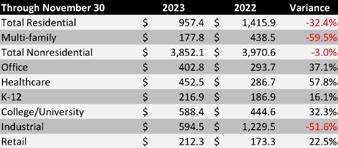
A steep decline in apartment construction pushed new housing starts in Pittsburgh to the lowest level since 2012. Source: Pittsburgh Homebuilding Report.
Steep declines in industrial and multi-family offset strong doubledigit gains in all other project sectors for nonresidential/commercial construction from 2022 to 2023. Source: Tall Timber Group, Pittsburgh Homebuilding Report.
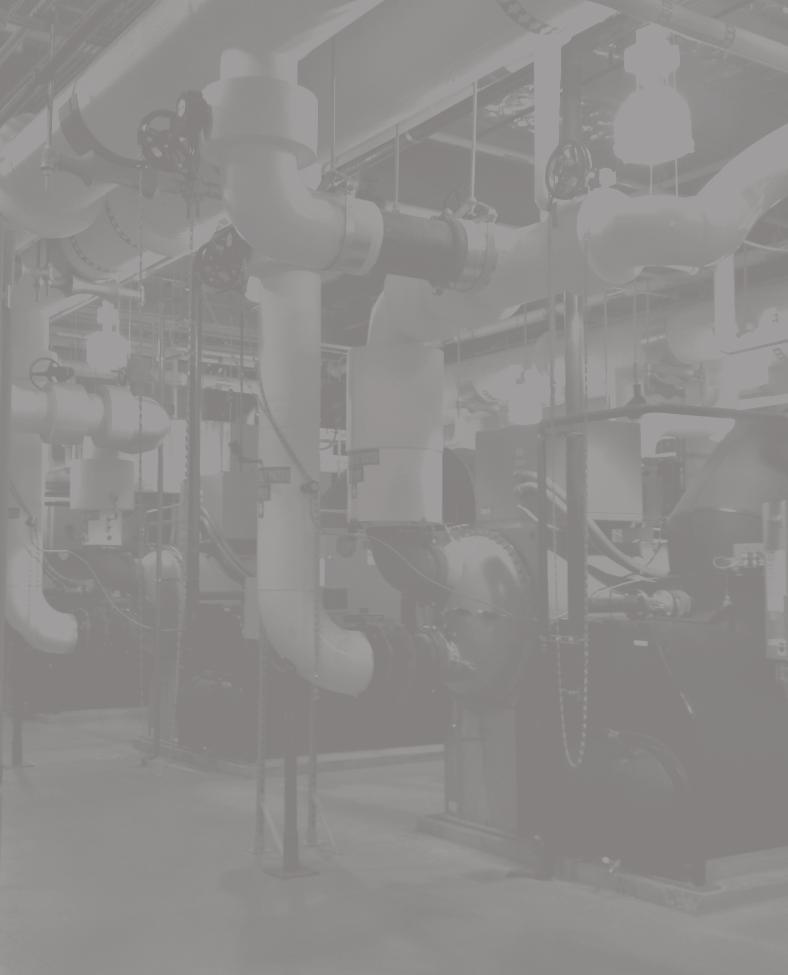
NATIONAL MARKET UPDATE
The U.S. economy continued to show resilience in the face of higher interest rates into the fourth quarter. Most of the headline economic data indicates high demand for goods and services, and an insufficient supply of workers to meet demand. Below the headlines, however, there are stronger signals that there will be a slowdown in activity that the Federal Reserve Bank has been attempting to achieve.
Gross domestic product (GDP) is a good example of a metric that is slowing, even as the headlines say otherwise. The second estimate of third quarter GDP outpaced advance estimates (with the exception of the Atlanta Federal Reserve Bank’s forecast), coming in at 5.2 percent. The most upbeat news in the GDP report was the 3.3 jump in direct purchases to U.S. providers of goods and services. Beneath the headline, two other measures indicate that GDP will slow significantly in the fourth quarter.
Economists pointed out that more than one-fourth of the third quarter gain was due to inventory buildup. Manufacturers and wholesalers loaded up on machinery and equipment, likely to replenish depleted stock that was allowed to dissipate during the middle of the year. Investment in new warehouses also accounted for a larger-than-normal share of investment in structure.
The second indication of slowing was in the measure of gross domestic income (GDI). While GDI and GDP should theoretically be equal, differences in how the two are measured lead to variances. During the third quarter, GDI grew at a 3.1 percent annualized rate, a healthy rate of growth but significantly slower than the GDP growth rate. Consumer spending was revised downward from the first estimate also, to 3.6 percent. The momentum from income and spending
appears to be slowing as the fourth quarter began. There were other metrics that point to further cooling of the economy.
Manufacturing activity remained cool in November, according to the Institute for Supply Management’s Purchasing Manager’s Index (PMI). The manufacturing index was flat from October to November at 46.7, the 13th consecutive month in contraction territory below 50. The PMI has been range bound between 45 and 47 for most of 2023, an indication that manufacturers are managing output to lower demand. New orders, inventories, and pricing were all reported as improving, although still below the expansion level of 50 or higher. Manufacturing employment fell from 46.8 to 45.8, another indication that employers were being proactive in managing slower orders.
Employment remained strong for most U.S. sectors and hiring in November was solid, with employers adding 199,000 jobs during the month. November marked the 35th consecutive month of employment growth; however, the slower pace of hiring continued a year-long trend. The three-month moving average of employment growth was 204 after November’s Employment Situation Summary was released on December 8. That moving average was above 600 in February 2022, and has been falling slowly but steadily since January 2023, when the three-month moving average was at 334.
The November employment picture also revealed that job gains were less broad-based. More than 30,000 added jobs came from the return of striking auto workers and only two sectors had significant job gains. One was government and the other was healthcare, which is hiring to backfill the high levels of resignations that followed the pandemic. One continued upbeat note was the decline in unemployment again to 3.7 percent, even as more people joined the workforce.
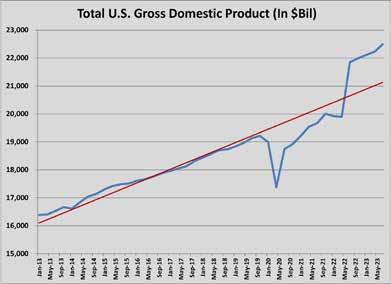
Trends in the American Institute of Architects’ Architectural Billings Index (ABI) are reflecting signs of slowing future construction. October’s ABI was at 44.3, the third straight month below 50. (A reading below 50 means more firms saw declining than growing billings.) October marked the ninth month below 50 since October 2022 and saw new inquiries below 50 for only the second time since July 2020. ABI is a simple binary survey, has proven very reliable as an indicator of future activity. With billings consistently lower than the previous month, however, it is almost certain that building construction will be lower nationally in 2024 than in 2023.
The slowdown in design activity has yet to be reflected in construction spending. The most recent data available, for October, saw another slight increase in construction. Total spending topped $2 trillion for the third consecutive month. Construction



Source: U.S. Census Bureau.
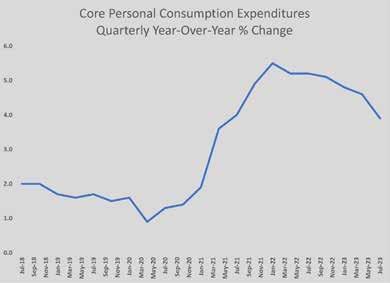

Consumer spending has spiked for 30 months at the same time consumers have expressed lower confidence in the economy. Source: University of Michigan, Bureau of Economic Analysis, Federal Reserve Bank of St. Louis.
activity rose 0.6 percent from September to October and was up 10.7 percent year-on-year.
Data on construction spending in recent months has continued the cyclical trend of increased nonresidential and decreased residential investment. The divergence in spending reaches back to mid-2022, when residential investment peaked at just under $970 billion. Residential construction has begun to recover, but remains nearly $100 billion lower than the May 2022 peak, while nonresidential construction is $140 million higher than that same month. In past business cycles, nonresidential construction has increased for 18-24 months after residential construction peaks before a decline in nonresidential investment begins.
New home construction was relatively level in the third quarter, averaging just below one million singlefamily homes and roughly 400,000 multi-family units. Permits for new homes and new construction starts peaked for this business cycle at the 1.8 million annualized rate in the fourth quarter of 2021. During 2023, however, activity has consistently been within 100,000 units of 1.4 million each month.
Inflation continues to moderate, moving below the long-term average of 3.28 percent in October and November. According to the Bureau of Labor Statistics’ data, prices for all consumer items except food and energy rose 0.2 percent from September to October and were 3.24 percent higher than a year earlier. The consumer price index (CPI) was 7.75 percent in October 2022. November’s inflation reading was 0.1 percent higher than October, and 3.1 percent higher year-over-year.
The steepest decline in recent months has been in shelter inflation, which economists had stressed would lag the decline in overall inflation by about 12 months. Shelter inflation comprises 60 percent of the overall CPI. With shelter costs stabilizing at a rate of just above two percent on an annualized basis, it is likely that the core inflation rate that the Federal Reserve is measuring will be at or below 2.5 percent during the first quarter of 2024. Because of the shelter inflation lag, economists at Penn State’s Smeal Business College have developed an alternative measure of core inflation that disregards the shelter component. That measure of inflation currently stands at 1.7 percent.
A declining rate of inflation is not deflation, which would result in prices for consumer goods and services falling closer to pre-pandemic levels. Consumers and homeowners have thus far adjusted to spending more without cutting back significantly. If inflation returns to the desired two percent level in 2024, consumers will likely adjust further by reducing spending, especially since the amount of credit available to consumers is much lower than two years ago. With consumer spending driving 70 percent of GDP, the Fed will need to be sensitive to even small reductions in consumer
Core inflation fell to 3.9 percent year-over-year in the third quarter and has trended lower throughout the fall. Source: Bureau of Labor Statistics.
spending while it assesses if, and when, a reversal in monetary policy is appropriate. Most economists now expect a cut in the Fed Funds rate by mid-2024.
The task of assessing the economy is more difficult because of the unpredictable nature of the U.S. consumer. Measured by the University of Michigan’s Consumer Sentiment Index, consumers began to sour on the economy in late spring 2021, just as widespread vaccination unleashed the economy from the pandemic. Personal consumption spending had already
jumped by more than $1 trillion monthly at the time consumer sentiment began to fall in May 2021. The sentiment index fell by more than 43 percent over the following year, even as spending jumped another $1.7 trillion. Through October 2023, consumer sentiment remains 23 percent below April 2021 while spending is 15.7 percent higher.
October marked the first month since March 2023 that retail spending fell from the previous month. Consumers spent 0.1 percent less in October than September, which was 0.9 percent higher than August. Below the headline number, the decline was driven primarily by falling gas prices, which pushed sales lower by 1.1 percent, and declines of more than 2 percent in automobiles and furniture. Purchases of durable goods are more commonly financed. Continued weakness in durable goods purchases would suggest that the higher cost of consumer debt was chilling spending.
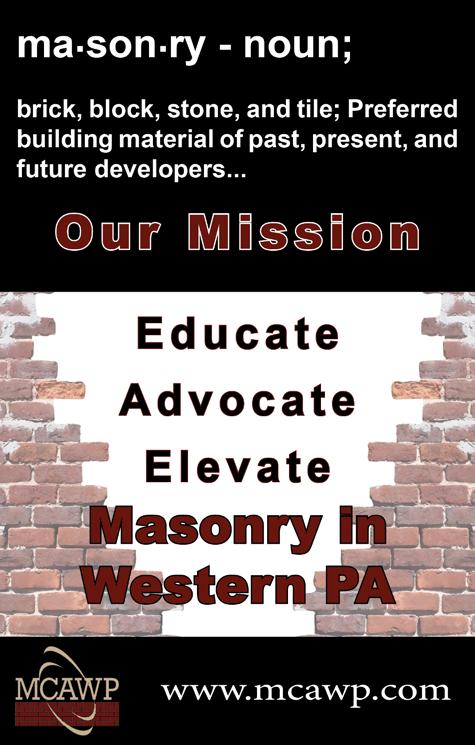
Most economists have looked at consumer debt and excess savings levels to assess that the fuel that drives spending is exhausted, and the expectations are that the consumerled economy will slow or contract in spring 2024. Consumer debt grew throughout 2023, and excess savings were exhausted by mid-2023. Consumer balance sheets are still strong. Spending continued at a booming pace in 2023, even though the cash to support it was spent. It seems likely that the U.S. economy will slow or grow depending upon how willing the consumer is to spend future income in 2024.
The consumer, and businesses, got some good news on that on December 13, when the Federal Reserve’s Open Markets Committee announced that it was leaving the Fed Funds rate unchanged and forecasted three rate cuts in 2024. The latter was a sharp reversal of the position Fed governors were taking until just recently. Wall Street responded with a new record high. Declining rates will help consumers with revolving and variable rate debt. Fed rate cuts invariably exceed what is forecasted. If that is the case in 2024, conditions will begin to favor refinancing of mortgage debt taken on since mid-2022, further easing consumer finances and boosting home sales and new construction. And lower rates will help unlock the frozen commercial real estate market, easing worries that lenders were sitting on major unrealized losses.
Lower rates will not solve every economic concern, but a reduction in the cost of borrowing may be the final step in achieving the soft landing that policy makers desired in March 2022. BG
WHAT’S IT COST?
Prices continued to rise at a slower pace in November. With a couple of exceptions, notably shelter inflation and transportation, consumers saw more relief at the grocery store and gas pumps. Producers continued to see inflation below the desired two percent level, with numerous materials experiencing deflation compared to both 30 and 90 days earlier. The overall producer price index (PPI) for final demand was down 0.3 percent from October to November and increased 0.9 percent from November 2022.
Inflation specific to construction materials declined from October to November. The PPI for final demand construction was -0.1 percent. The bellwether index for new nonresidential buildings was 0.2 percent lower than October and 0.3 percent higher year-over-year. Associated General Contractors of America tracks the bid price for new nonresidential buildings, which was only 0.3 percent higher year-over-year.
Prices for virtually all major materials fell from October to November or were up 0.3 percent or less. Except for scrap iron and steel, year-over-year PPI for all materials were compressed, if positive, compared to October’s levels, or declined further. Scrap metals increased ahead of increases in basic rolled steel prices that were announced when the United Auto Workers strike was settled in November.
Two major construction management building cost indexes reflected the cooler material price escalation. The Turner Building Cost Index was 1.7 percent higher from the second quarter to third quarter and was 3.7 percent over the fourth quarter of 2022. Mortenson’s Quarterly Cost Index was up 0.19 percent for the quarter. Mortenson’s data found construction labor costs flattening, up 0.1 percent, with subcontracted labor up 0.9 percent.
The outlook for producer price inflation of construction materials is calmer. There are more indications that U.S. construction activity will slow in 2024. Funding boosts from the Bipartisan Infrastructure Law, American Recovery Plan, and the CHIPS Act will push
infrastructure spending higher, but demand for construction overall is slowing as 2024 begins. Materials that are heavily used in infrastructure, like cement and asphalt, are unlikely to experience declines in price. Those that are more heavily used in building construction will feel more pressure from growing inventories. BG
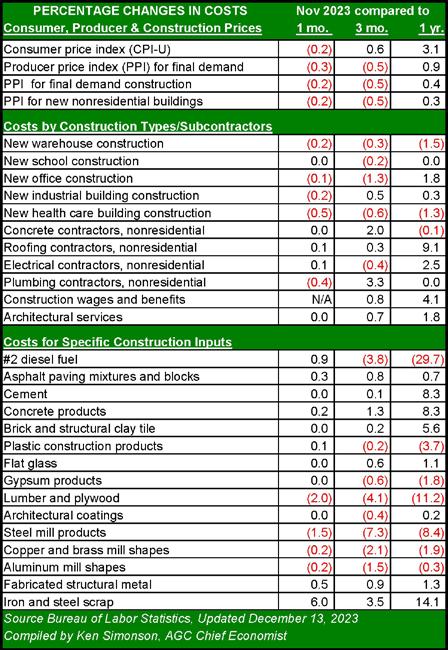
Framing is under construction for the ticketing area (see rendering top-right).
It is the Pittsburgh region’s biggest construction project. Coming on the heels of the Shell cracker, the Pittsburgh International Airport Terminal Modernization Program (TMP) ensures that the regional construction industry will have had a billion-dollar project underway for nearly a decade. It is also a project that defied the rollercoaster ride of a global pandemic and a post-pandemic inflation spike.
THE BIG PICTURE: IMPACT
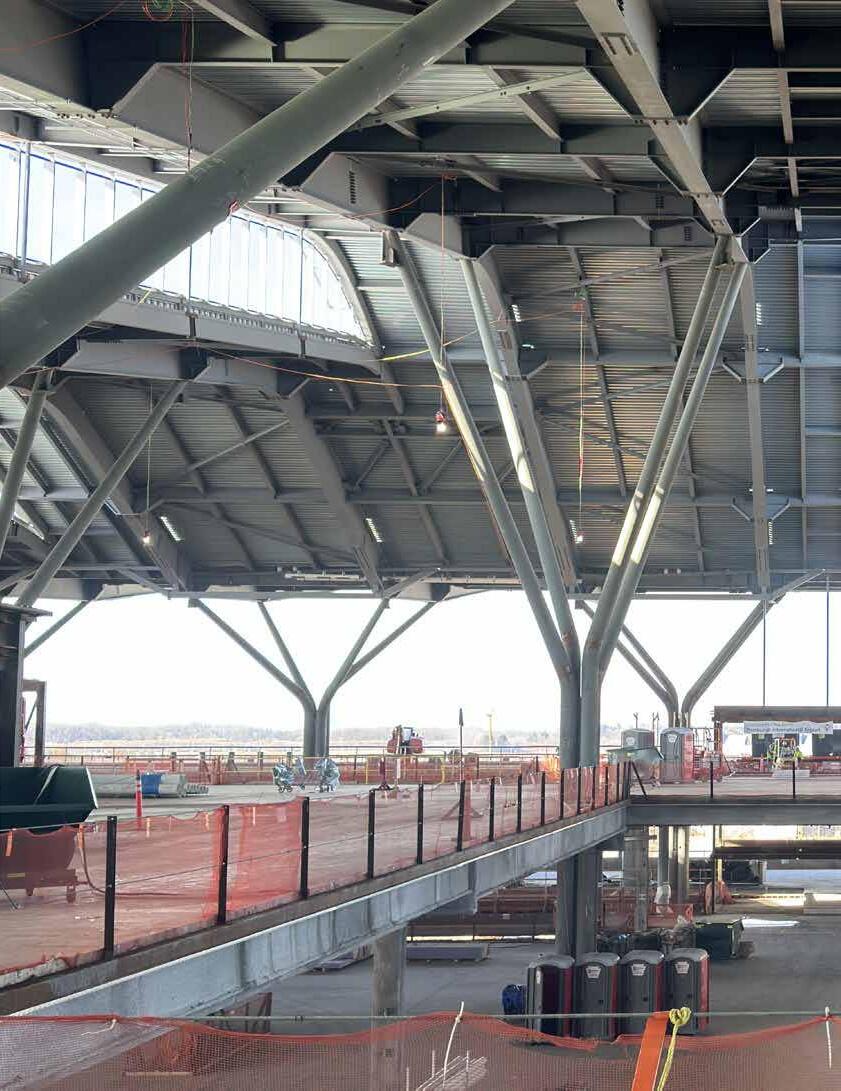
Photo by PJ Dick Inc.

IMPACT OF THE NEW AIRPORT



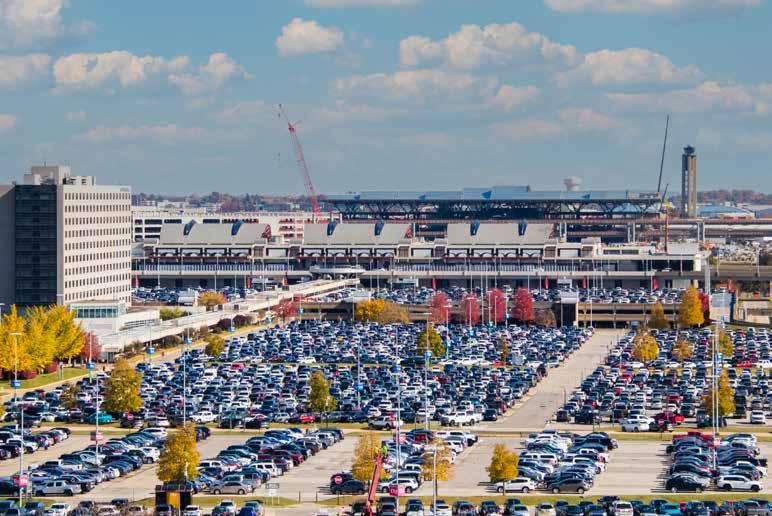
Pittsburgh’s TMP is somewhat unique among major public construction investments in that it is being undertaken with the intention that the project will primarily benefit the users of the airport, rather than having a multiplying economic impact. For that reason, the construction costs are being borne by the airport’s users instead of the county’s taxpayers. That does not mean that the project is without its detractors, mostly those who ask why the project needs to be done.
Commercial air travel is relatively new in terms of human activity. The equipment and facilities used to operate airlines and airports are still evolving. That means airports can become obsolete quicker than a courthouse or elementary school. The new terminal will effectively replace the current 31-year-old Pittsburgh International Airport, which replaced the Greater Pittsburgh International Airport only 40 years after it opened in Moon Township in 1952.
When it opens in March 2025, the new terminal will change the experience of traveling to and from Pittsburgh by air. There will be triple the amount of covered parking. The security checkpoint will be twice as large. The designers estimate that the time needed to go from curbside to airside will be cut in half. That is a major improvement in function, and the new airport’s design is meant to improve its form too.
The modernization is intended to give Pittsburgh the airport it deserves, in the words of Christina Cassotis, CEO of the Allegheny County Airport Authority (ACAA). While it is being built, the modernization program is giving the construction industry in Pittsburgh a boost it needs.
Understanding the Need
Pittsburgh International Airport (PIT) opened in October 1992 to industry acclaim as an airport of the future. Built at a cost of $800 million, PIT was the first in the world built as a connecting complex, with a pre-security landside terminal and an X-shaped airside terminal with four concourses. Its design was lauded in the travel industry for its efficiency, especially for the reduced idling distances that planes were required to traverse, an improvement that saved the airlines $12 million annually in fuel costs alone. PIT also pioneered the modern air mall, with the groundbreaking agreement with retailers to price merchandise at levels that matched their other locations outside airports.
But PIT also opened a few years ahead of disruptive change in the airline industry. The airport was built as a hub for U.S. Airways, which was beginning to experience financial pressures. Less than nine years after PIT opened, terrorists highjacked commercial domestic flights to attack Manhattan and Washington DC on September 11, 2001. Three years later, U.S. Airway abandoned PIT as a hub.
The move by U.S. Airways reduced the number of daily flights by 250. PIT became underutilized and remained so for most of the next 20 years. When the ACAA hired Christina Cassotis as CEO in 2015, her charge was to rebuild origination and destination (O&D) traffic from the ground up. Today, there are 61 non-stop O&D flights daily, almost double the 36 daily non-stop flights in fall 2015. But that additional traffic, while impressive, cannot generate the kind of utilization that an airline hub of the 1990s would create.
The new terminal is being built directly adjacent to the landside terminal that will be demolished after the TMP is completed in 2025. Photo by Fly Pittsburgh.
Jonathan Potts, vice president of communications for the ACAA Terminal Modernization Program, points out that while fewer flights may have resulted in fewer passengers overall, the change in the type of flights has also created an imbalance in how the two terminals are used.
“Bear in mind that we are only replacing the landside terminal – where you check in, go through security, and pick up your bags – and not the airside terminal,” says Potts.
“Here’s why: When Pittsburgh International Airport opened in 1992, we were a U.S. Airways hub, and the airport was built to U.S. Airway’s specifications. Back then, 80 percent of our passengers were connecting passengers, so they never set foot in the landside terminal. They landed in the airside terminal, got off their plane, and then got on another plane to fly to their final destination.
“U.S. Airways went through two bankruptcies, de-hubbed PIT, and was swallowed in a merger with American Airlines. Today, PIT is an origin-and-destination airport. So, 95 percent of our passengers begin and/or end their trip in Pittsburgh. That means there are many more people using the landside terminal today than there were when we opened 31 years ago. It is inadequate for our passengers’ needs, and many of the systems and equipment are aging out and prone to breakdown.”
Moreover, one of PIT’s more popular assets, the massive 12,000-acre footprint and sprawling facilities that kept passengers from being overcrowded and bottlenecked,
became a liability. Passengers must travel longer distances and manage an inefficient post-9/11 security process that is less convenient than in airports designed or updated since 2001. The large amount of unused or underutilized space also means that ACAA spends much more on maintenance and cleaning than it would on facilities that were right-sized.
Cassotis has advocated for an airport that matched the reality of air travel in Pittsburgh in the 2020s and 2030s. She detailed the major issues that ACAA faces operating a 1980s-designed airport in a recent editorial in the Pittsburgh Business Times.
“The landside terminal, where you check in, go through security, and drop off and pick up baggage, needs to change. It was built before TSA existed and for an airline that no longer exists,” Cassotis wrote. “We have an outdated baggage system that includes a lengthy eight miles of baggage belt. We have an international arrivals process that is badly in need of redesign. We have conveyances, like escalators and elevators, in a four-story building that are 30 years old and in need of replacement, and trains that cost millions annually to maintain. Functionally it no longer makes sense.”
Defining the Solution
In June 2018, ACAA selected Jacobs and Paslay Group from Irving, TX as program managers for the terminal modernization. One month later a design team was selected,
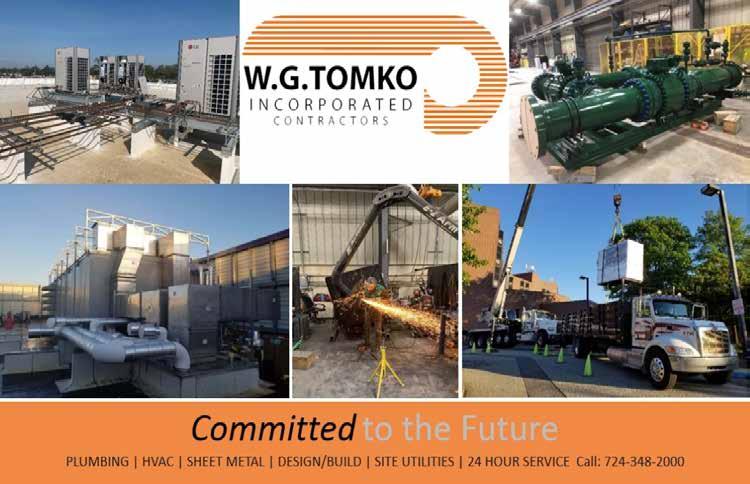
led by a joint venture of Gensler and HDR, in association with Spanish architect Luis Vidal + Architects. Michael Baker International, which has served the ACAA for 30 years, is also providing engineering and architectural services for the Multi-Modal Complex (MMC). The team includes dozens of professional firms as subconsultants. It was the ACAA board’s and Cassotis’ directive that the architects create a design that reflected the values and characteristics that are unique to Pittsburgh. The result was a concept they called, NaTeCo, an acronym for nature, technology, and community.
“It was important to the airport authority to design a place that was uniquely of Pittsburgh. Pittsburgh International is an origination and destination airport, so the first impression people get of the city and the region is often the airport,” explains Carolyn Sponza, studio director and principal with Gensler. “The NaTeCo concept pulls out three of the major drivers of what we think is important to Pittsburgh and tries to infuse those in the architectural character of the airport.”
Sponza lays out how each of the three parts of the concept is represented in the final design.
“We wanted passengers to have the benefit of exposure to nature and the positive biophilic relaxation qualities of being in nature while they were in the airport. Western Pennsylvania has the change of seasons, all the lush landscape, and the tree covered hills,” she says. “Some of the natural features we’ve integrated into the airport are a series of outdoor
terraces that speak to three of the microclimates or natural regions of Western Pennsylvania. In the architecture itself there are natural features. The form of the roof replicates the rolling hills of Western Pennsylvania. Also, the tree-shaped columns are a signature structural support on the upper level of the building. There are also little details in the design such as leaves that are indigenous to Western Pennsylvania embedded around the base of those tree columns.”
Sponza says that the design team focused on using technology in a way that mimicked Pittsburgh’s leadership in emerging technologies, using smart technologies that help to guide passengers and make the experience of traveling to Pittsburgh more intuitive and less stressful. She explains that for the third concept, community, the design team examined how PIT was currently being used to bring the community into the airport.
“One of the things we did when we started was to audit all the things that the airport was already doing. It’s only because you have a great space that is multifunctional that you can have different people come in and do different programming from the community,” she says. “We wanted to make sure there was space for all those activities in the new plan, both on the outdoor terraces and inside. We really thought about how the community be welcomed in and use the space.”
The design concept was revealed in early 2019. In April of that year, the construction management team was selected.










IN A WORLD WHERE RESILIENCY IS NEEDED MORE THAN
EVER,
Construction management for the TMP is split. The team of PJ Dick/Hunt is the construction manager for the new terminal and existing terminal renovations. Turner Construction is the construction manager for the Multi-Modal Complex, including the new parking garage.
The new terminal is 700,000 square feet and combines the airside and landside functions that were separated in the 1992 design. The TMP also includes the 1.42 million square foot Multi-Modal Complex that will house the rental car facilities, with space for 1,000 rental cars, and a 3,300-car parking garage available for passengers and the public. At the time it was approved, the TMP was to cost $1.2 billion. That budget has since been increased to $1.57 billion, as time and extraordinary circumstances have dictated.
“In terms of the cost, we are not using local or state tax dollars, though we are receiving some federal infrastructure funds –about $23.5 million in federal dollars,” says Potts. “Most of the $1.57 billion for the project comes from long-term bonds that will be repaid from airport operating funds. We do not operate with tax dollars. Our revenues come from fees paid by the airlines that fly out of PIT, parking, concessions, and other miscellaneous fees.”
Potts notes that the operating costs for the airport will be positively impacted by the reduction in size and improved efficiency. In 2023 dollars, ACAA will save $18 million annually at the current levels of flights and services.
One of the major risks of a project of this size is its timing. Planning for the TMP began five years before the professional team was assembled. During the airport’s design, Shell Chemicals was building its $7 billion polymers plant in Monaca. Airport leadership was wary of the risk of budget creep over such an extended period and determined that the project would be most successful if it attracted Pittsburgh’s best contractors. Paul Hoback, executive vice president and chief development officer for ACAA, notes that there were decisions made during planning that were intended to optimize the market’s attention on the TMP.
“We wanted to set the project up for its greatest success. First and foremost, we wanted to make this the project of choice in the region,” he says. “We made sure we bid this just as the Shell cracker plant was coming to completion. There were 8,000 construction workers just 19 miles away from this airport that were going to be available around the time we went to market. We wanted to make sure they were choosing this legacy project. We also made sure that we had things like on-site parking for the workers. I can’t tell you how important that is to our workers to have on-site parking where they can walk directly onto the job site. That was not the case at the Shell project. We have health and wellness programs in place for all the team members. I’m also extremely proud of our safety program.
“We made sure that we segregated the project site as much as possible from the daily operations of the airport. It was important to set that up to get the most competitive bids, because if contractors had to go through the TSA
requirements in a secure area of an airport it would add significant costs.”
The TMP is operating under a unique safety partnership with the Occupational Safety and Health Administration (OSHA). Hoback says the partnership allows OSHA to share industry best practices and provide timely feedback on conditions at the airport job site. He says it creates an unusual dynamic for OSHA at the TMP site.
“Most of the time OSHA is a regulatory agency that comes to projects in response to a problem. We have a partnership that is the first of its kind and we invite them out all the time. OSHA helps us make sure we’re implementing best practices that create the safest environment,” Hoback says.
For all the advanced planning and intentional decision making ahead of the start of the TMP, ACAA and its team could not have been prepared for what unfolded in March 2020. When the COVID-19 outbreak occurred, construction of the enabling packages had just begun. The design was at the point of being refined to begin bidding on the early packages.
“I think the biggest challenge was getting the project design completed during the pandemic. We had just done a big presentation the week before COVID hit. We were used to working collaboratively in person and then everything was remote,” Sponza recalls. “Suddenly, we were completing this airport design during a time when there was a lot of uncertainty in the world. It was a challenge to navigate that and anticipate how much the world was going to change and how much that would change the building we were designing.”
Hoback also pointed to the pandemic as the biggest challenge, but for the ACAA the problems extended beyond the design and construction challenges.
“We had started early enabling projects and were at 90 percent complete on the design, ready to bid the whole project when COVID hit,” he says. “We were also negotiating an airline agreement and it’s the airlines that are paying back the debt for the construction of this airport. We had finalized the terms and had signed contracts from two of our partners when the pandemic hit. At that moment the airlines needed to step back, and those agreements became void. Airlines are our biggest customers and we had spent six or seven years up to that point meeting monthly with them preparing for this project. It took about 16 months, but we got an airline operating agreement approved in the middle of a pandemic and it was unanimous. We were the first U.S. major airport capital program that was approved in a post-pandemic environment.”
Site work construction began in April 2021, with the terminal buildings getting underway six months later. Several of the project’s biggest packages bid in 2022 and 2023, meaning that the bulk of the bidding took place while cost escalation was on its way to a September 2022 peak of 24 percent. While that steep ascent has been followed by an equally steep decline over the past 15 months, the construction management team and ACAA had to be nimble to adjust to the conditions. Except for the initial structural steel package, which bid in spring 2021, virtually all the bid packages have

come within expectations. The construction management teams were realistic about the market conditions and relied on the contractors bidding the packages to anticipate escalation in their bids.
“Each package has been a lump sum bid. The risk of escalation is on the prime contractors. There are no provisions for escalation built into the procurement,” says Jeff Turconi, who retired as president of PJ Dick Inc. in April 2023 but remains the executive manager at the joint venture for the TMP. “We expected contractors to understand the volatility of the market. Thus far, I don’t think it’s been an issue. Contractors have not come back to us and said that they were being hurt by unexpected escalation. It’s been well known that prices were going up. We have adjusted the budget. If you threw out the steel bid, most everything else has fallen in line with what we adjusted once we realized that the pandemic had caused a significant amount of escalation in a short period of time.”
With nearly all the major packages bid and awarded, the TMP has seen milder inflation of costs over budgets than the market in general. Hoback estimates that the escalation has been 12 percent, roughly one-third the rate of the overall market escalation during the same period. He attributes the better performance to extensive planning and regular revisiting of budgets ahead of bidding.
“In my mind, it was because we always expected the unexpected,” Hoback says. “We were able to control costs to a degree because we thought through all these things. I
will tell you that when the pandemic hit, we had to make sure we had a construction management team that understood the industry, procurement, and the pandemic’s impact on the timeline. We had to build in extra time that we knew we were going to need.”
The adjustments made in response to the pandemic and its aftereffects – particularly the disruption of reliable lead times from the supply chain – put the project about six months behind the original schedule. According to Tara Connor, preconstruction manager at Turner Construction, the MMC will be completed in the fourth quarter of 2024. ACAA officials are still confident that the project will open 15 months from now. For the construction management team, the challenge will be compressing the remaining work with a team of separate prime contractors. That requires a different level of cooperation than if the project was being delivered under the control of one single prime contractor. Thus far, the process has been working.
“It’s been very collaborative. We have not been adversarial with the primes,” says Turconi. “There are issues with manpower and changes to the drawings. We are cognizant of the issues and are working with the prime contractors to help them get the job done.”
Assessing the Impact
As a construction project, TMP ranks only behind Shell’s polymer plant in Beaver County as the largest in 50 years. Past the halfway point in construction, with all the major
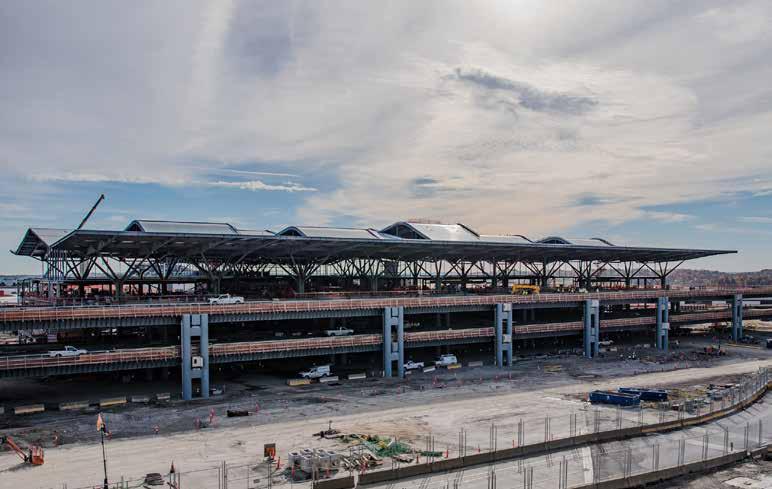
Photo by Fly Pittsburgh.




































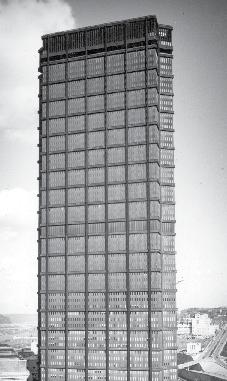



bid packages awarded, the TMP is on track to cost $1.57 billion, including soft costs. The planning and design of the project occupied 563 jobs. During construction, the TMP will create 5,548 direct construction jobs. The project will have generated $1 billion in payroll compensation when it ends, resulting in $27 million in state and local income taxes (using 2021 dollars). Its total economic impact is estimated at $2.5 billion, resulting in 14,300 direct and indirect jobs.
For Christina Cassotis and ACAA, the TMP will result in an airport that functions in a way that is commensurate with the airline industry’s expectations and Federal Aviation Administration regulations. The new terminal and MMC should extend the life of Pittsburgh International Airport by 40 years. The more efficient airport should produce revenues over expenses that allow for the bonds that financed the project to be repaid without the kind of financial stress that accompanied the retirement of the 1991 debt.
None of these outcomes are bad, either for the traveler, the airlines, or the taxpayer. What separates the TMP from many other major public investments is that the rationale for the project does not depend on downstream effects that may not occur and that would be difficult to track. The modernization is not intended to be a catalyst for new development around the airport, at least to not any degree that the current airport location attracts development. The most significant downstream opportunity for development will come from the disposition of the existing landside terminal.
“There is going to be a direct benefit for development opportunities once we demolish the existing landside terminal,” explains David Storer, director of commercial development for ACAA. “That will open up eight acres for development with proximity to the new terminal and the existing parking and roads. You’re talking about a fully pad ready site.”
The current landside terminal is designated for aeronautical use, since it directly supports the airport’s primary activities. To facilitate development of the land, once the terminal is demolished, ACAA will work with the FAA to change the designation of the property to non-aeronautical use. Storer suggests that the best use of the property may still be airport related.
“There was an office park recently developed in Tampa with terminal adjacency where the airport authority has its offices as well as many of the companies that support the airport. We have many firms that support our operations from engineering to operations,” he suggests. “Beyond that, I don’t know that we will see a lot of economic development. We built the terminal to control costs and improve the passenger experience. The terminal is not expected to attract new airlines.”
Regional real estate and economic development professionals mostly echo Storer’s view on the economic impact of the TMP. The consensus view is that the new terminal is a gain for the region, but the benefits will be felt by properties near the airport.
Rendering by Fly Pittsburgh.
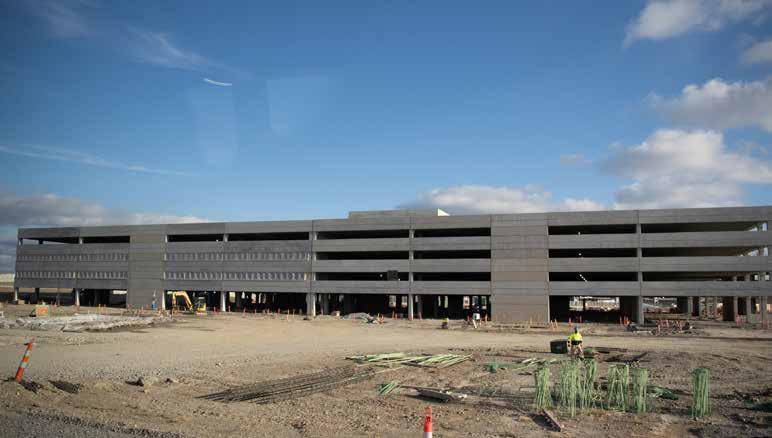
“I don’t anticipate any economic impact from that project other than that which we already see from our proximity to an international airport. Its change, while important to us because it operates as an efficient and effective connection to the world, doesn’t have any additional impact,” says Lew Villotti, president of Beaver County Corporation for Economic Development. “I can tell you that because of its location and our proximity to PIT, we’re in discussions with several companies that we would not be without that proximity to the airport and its effective operations.”
“The new terminal should only help the regional economy, but any real impact to the local industrial real estate market would be more driven by air cargo than an improved passenger terminal,” says Rich Gasperini, principal and founder of Genfor Real Estate.
Gregg Broujos, senior vice president, leasing at The Buncher Company, agrees that the impact on the industrial market would be greater were the project to include an expansion of the cargo capacity. But he cites the improvements to passenger service as an enhancement of the benefits of proximity to the airport, something that has helped Buncher’s Neighborhood 91 development.
“Neighborhood 91 is an additive manufacturing ecosystem that we developed with Pitt. The first building at Neighborhood 91 was successful in part because of the adjacency to the airport,” Broujos says. “We have multiple additional buildings planned and the new terminal will be even more significant for those developments. We hear time
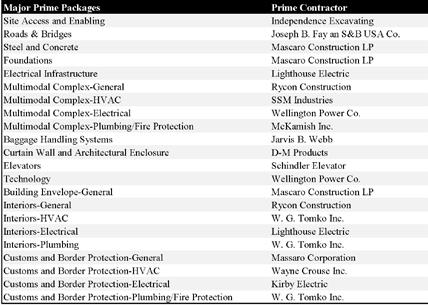
The massive 3,300-car garage will triple the amount of covered parking for the public. Photo by Fly Pittsburgh.





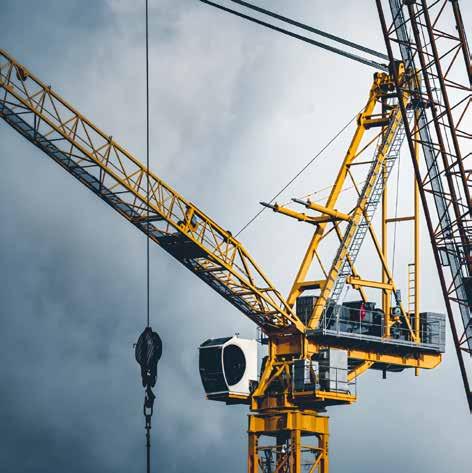
and again from tenants of the first building that they can get materials from Germany in 24 hours. They can get people in from Germany for a tour and they can be to Pittsburgh and back within 24 hours. The new terminal will make that proximity for Neighborhood 91 even more important.”
“The new terminal at the Pittsburgh International Airport will certainly have a real estate and economic impact on Washington County,” says Jeff Kotula, president of the Washington County Chamber of Commerce. “In terms of real estate, the new terminal will serve as the northern bookend to the recently opened Southern Beltway with Southpointe serving as the southern bookend. With the ease and speed of access between the two locations, Washington County is strategically located for real estate growth along that corridor. We already see signs of that potential with Imperial Land Corporation’s investment at the Fort Cherry Development District and expect that additional industrial, commercial, and flex-space expansion to follow.”
“Considering the overall economic impact of the terminal modernization project, it will encourage more leisure and business travelers as well as provide an exciting ‘first impression’ for the Greater Pittsburgh Region,” Kotula continues. “Christina Cassotis and her team at the Pittsburgh International Airport should be credited with thinking big and, more so, smart about the modernization as the airport already drives $30 billion in economic impact to this region and with the new terminal, we expect that to increase.”
“Any additional traffic through that marketplace is good for us. A rising tide lifts all boats,” says Tony Rosenberger, president and chief operating officer of Chapman Properties, the developer of the 300-acre Chapman Westport three miles south of the airport off the Southern Beltway.
The airport corridor has been a focus of regional economic growth for 60 years. One-third of metropolitan Pittsburgh’s suburban office space is located between Green Tree and PIT. Findlay Township, where the airport is physically located, has been a hot bed of industrial development for two decades, aided by the designation of the Parkway West as Interstate 376. With the Southern Beltway now open as a limited access highway to Southpointe and the Shell Chemicals plant operational along the Ohio River in Beaver County, the airport corridor runs north-south as well as east-west. The airport is the nexus of the four-way corridor. A major improvement in the functioning of the airport enhances the corridor as well. For an economic impact, that may be enough. BG
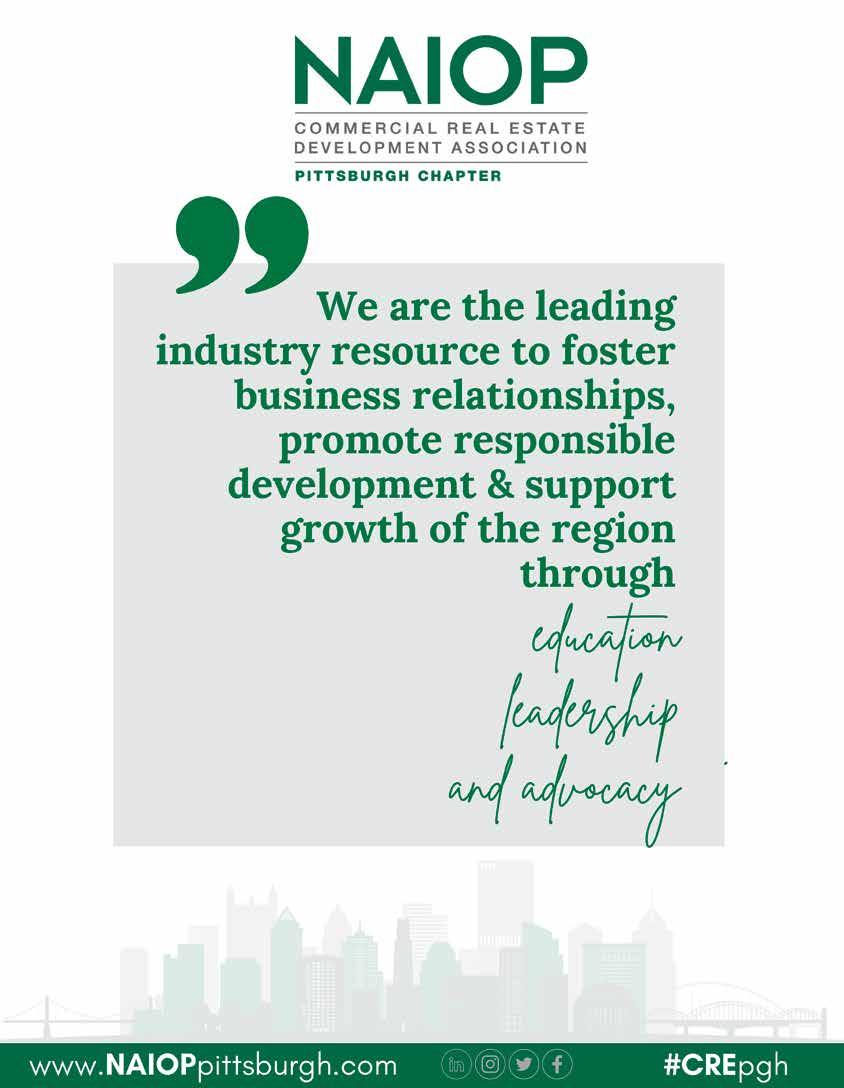
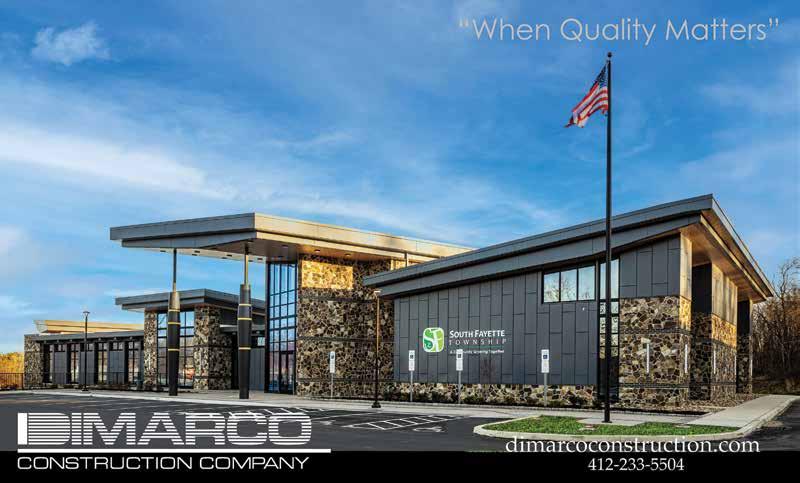

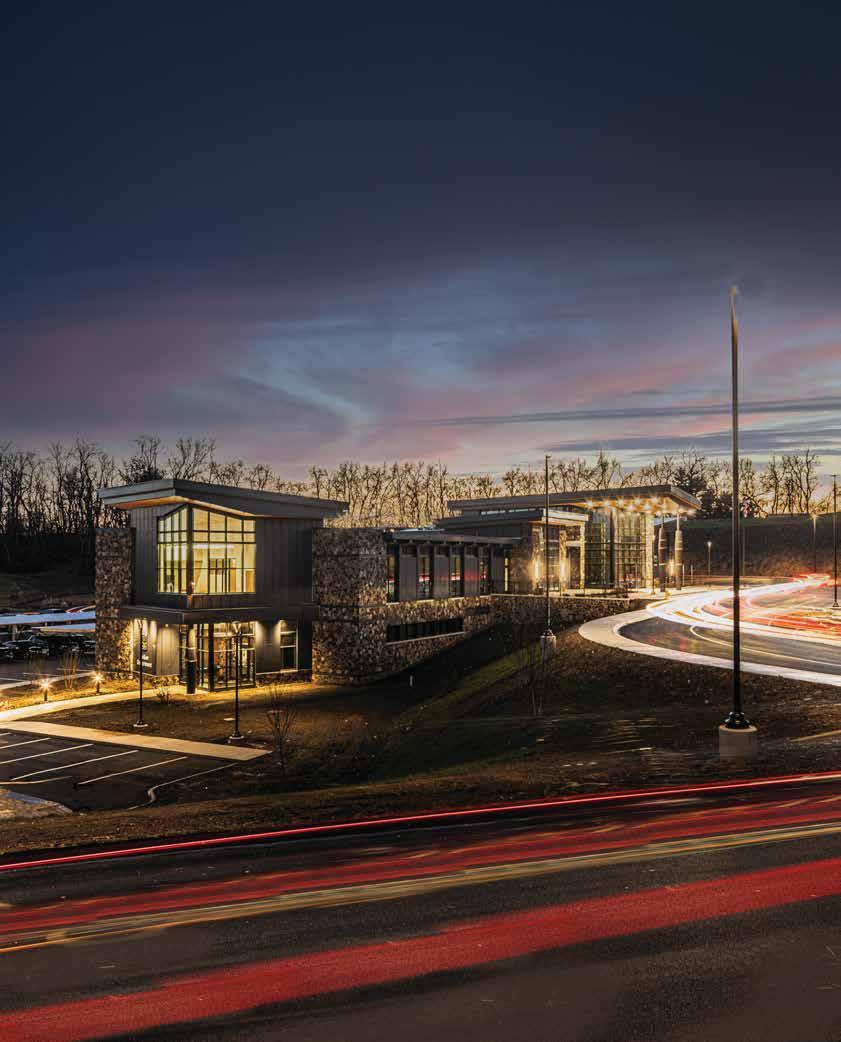
NEW SOUTH FAYETTE MUNICIPAL COMPLEX
Photo by Roy Engelbrecht Photography.
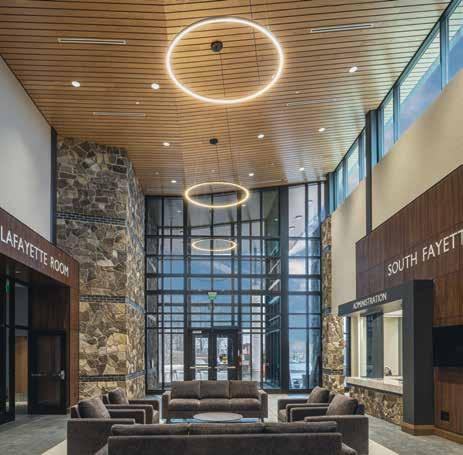
For the past two decades, South Fayette Township has been one of the fastest growing communities in metropolitan Pittsburgh. While it does not get the kind of publicity that Cranberry Township got during the 1980s and 1990s, South Fayette Township has outpaced Cranberry Township in new residential construction. In the past 15 years, nearly 1,500 new single-family homes, totaling nearly $500 billion in construction, have been built in South Fayette Township.
That new construction brought a surge in population. There were 18,358 people living in South Fayette Township in 2020, an increase of 27.3 percent since 2010 and nearly 50 percent since 2000.
As all that growth occurred, the township’s municipal staff and police operated from a building on Millers Run Road that was opened in 1958. Including additions in 1963 and 1996, the building totaled only 11,000 square feet when the township supervisors decided to build a new facility in 2020. The building was being shared by the community library, housed more than a dozen administrative staff, and 23 police officers. It was the needs of the latter group that tipped the decision to relocate.
“The most pressing need, and what drove the pace of the project, came from the police department,” says John Barrett, South Fayette Township manager. “We have 22 full-time officers, and they were operating out of 3,500 square feet. Their locker room facilities were inadequate. They had rooms where there were files from floor to ceiling. They had no physical space for
any more stuff, and police tend to accumulate stuff. We had no ability to accommodate additional modernized equipment. That really drove the project.”
As the township supervisors began contemplating a new building, a chance encounter led them to an architectural firm, Kimmel Bogrette Architecture + Site, that would eventually design it. Barrett recalls that Martin Kimmel, one of the firm’s co-founders, was speaking about challenges facing municipalities at the Pennsylvania State Association of Township Supervisors. He and the supervisors were impressed with the presentation and invited Kimmel Bogrette to compete for the commission to design South Fayette Township’s new building, even though the architect is based in Blue Bell, PA. Kimmel Bogrette’s proposal proved successful.
“We learned during the interview process that they had been selected for some Pittsburgh projects. We wouldn’t simply be the only project they had in Western Pennsylvania. They were working in Peters Township and a couple of university campuses in the Pittsburgh area,” Barrett says. “We liked what they brought to the table. They seem to be very creative and made us feel that they would help us to the best extent possible to right size the project and choose materials that suited us.”
“We work with township and boroughs of all classes throughout Pennsylvania,” says Kimmel. “We see our role as helping the township’s elected officials make smart real estate decisions that create long-term value. A building like that is generational, meant to last 100 years with reasonable maintenance. Municipal buildings should be well-built, smart, and energy efficient. It was a challenge to balance those needs and desires with costs and a market that was challenging during most of the time we were designing and bidding. We were able to get the full value that we hoped for without making major cuts. Part of that was smart planning and part of that was a commitment from the township to look at it as a hundred-year building.”
Kimmel says that South Fayette’s needs were not uncommon for growing communities throughout Pennsylvania. He notes that a community that doubles in size does not need to add a township manager or tax collector, but the additional population strains public works and police. A new building for those functions was an opportunity to optimize South Fayette Township’s facilities to better serve its residents.
“There are three fundamental uses for the building. It started with them for the police. The police had so outgrown the facilities that they had that they were problematic from an officer safety and quality of building perspectives,” Kimmel explains. “While they were at that, they decided they wanted to build new for the administration. They also wanted a building that the community
Photo by Roy Engelbrecht Photography.
could use and would have a bit more sense of pride in than the current building. Making those three things work in a new world of security needs was a challenge. You want to have public access to a space, but having very secure and limited access to the non-public areas was very important.”
Township supervisors approved the purchase of 10 acres on Hickory Grade Road from Alan A. Axelson Intercare Properties Inc. in June 2020. The site helped influence how the building was designed.
“The site was a typical Western PA site in that there’s a lot of grade change to manage. We stacked the building in two stories, with the police on the bottom and the administration and public opening above to reconcile that grade in a smart way,” Kimmel says.
The final design was a 36,400 square foot, steel-framed building, with a stone veneer, metal panel accents, and lots of curtain walls and windows. Bids were taken in January 2022. While the bids were within budget, there was a complication. The low bidder on the general construction was nearly $2 million below the next bidder but did not withdraw its bid. When the second low bidder did withdraw its bid, the supervisors voted to consider the low bid unresponsive, awarding the project to third-lowest bidder, DiMarco Construction.

DiMarco Construction bid on the project with the understanding that the design and the circumstances were anything but straightforward. The key people were also anxious to have the chance to build the project.
“When the drawings came in, I felt like it was something I could get excited about building,” says Scott Wardle, senior project manager for DiMarco Construction.
“It was a complicated project from day one. If you look at that building, there isn’t a right angle on it,” agrees CEO Phil DiMarco. “From the foundation up, everything was complicated.”
During the preconstruction stage, Wardle identified a couple of key areas that were going to require extensive input from the architects and that could be construction headaches. But those concerns became a lower priority almost immediately when excavation began.
“We had challenges immediately with the site. It took forever on our end to get the project started. It seemed like we were in planning forever. We were so optimistic when the project starts and within 30 days, we hit some bad soil. It was the first time I heard the word carbonaceous,” chuckles Barrett.
“They were not aware of the pyrite issues they had. Even though they knew it was present, they thought they eliminated it when they filled some of the areas. As we got deeper, we found more,” says Wardle. “We had to undercut the building to remedy the
problem. Once we did that, we noticed that there was a lot of underground water, so we put a blanket drain under the entire building. That set us back 90 days getting it designed, priced, and installed.”
“We had a lot of ground water, some of which was expected and some of which could not be determined until we fully excavated. We worked hand in glove with DiMarco and their team to make sure that we could drain the site, so we never have any leaking in the lower level,” says Kimmel. “That was probably the one and only unexpected challenge we ran into, and we ran into it right away and had a solution for it.”
“After that the project really smoothed out,” says Barrett. “We envisioned having issues with supply chain and, to the contractor’s credit, we didn’t encounter much of that.”
DiMarco and Wardle chuckled when hearing that Barrett and Kimmel felt the project went as expected after the initial site problems.
“That’s good. We want the owner to feel that way, but there were plenty of other difficulties,” DiMarco says.
Most of those difficulties were the result of the market conditions in 2022 or of the complicated structural design. The former meant that prices were rising rapidly during the buyout phase of the project and that lead times were unreliable. The latter was a product of the challenging site and unique building design. The challenges started at the foundation.
Photo by Roy Engelbrecht Photography.


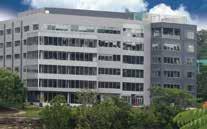


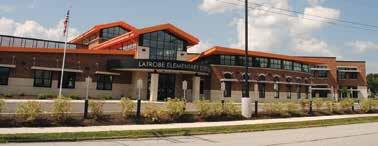
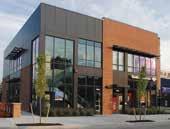

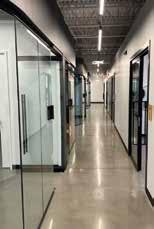


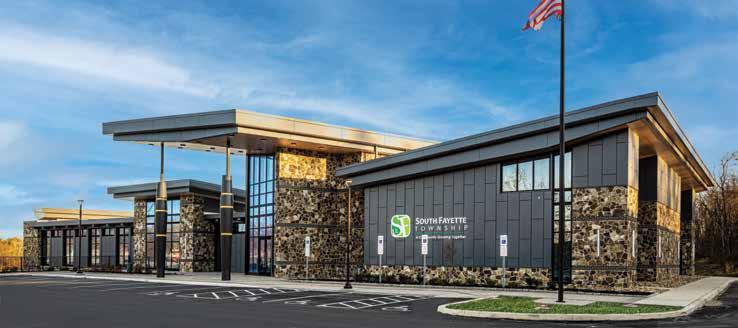
The form work for the foundation was unusual because of the angles and the extraordinary amount of reinforcing steel involved. The amount and complexity of rebar frustrated the ironworkers and was enough of a concern that DiMarco Construction brought in a consultant to confirm their approach. The main concern was that the density of the reinforcing steel would prevent the concrete from settling completely in the forms. Further complicating the concrete pour was the fact that the columns were recessed in the foundation, rather than set on exposed bolts. That meant the voids that would accept the columns had to be laid out precisely.
“The design of the reinforcing steel is nothing like I’d ever seen,” Wardle says. We usually put a certain amount of vibration on our frames anyway, but we had to put two rows of vibration to make sure that the concrete flowed to the bottom. It all worked, but everything took longer than anybody thought.”
Coming out of the ground was also complicated by an unusual design and the limited availability of even standard building materials.
“Once we started detailing the structural steel, we had over 200 RFIs [request for information],” recalls Wardle. “None of the angles were working. The steel vendor would send us 10 or 11 RFIs per day, but they had some complicated connections to detail. Trinity Steel really did their due diligence, and they came through for us.”
“I don’t think anybody realized how complicated the steel frame was because of all the angles. Initially the thought was that we could use steel joists, but at the time you couldn’t get steel joists, so it was done as a completely framed steel structure,” he continues. “When you see the building with these beautiful angles, you don’t appreciate how difficult it is to build.”
Managing a project that bid and started in early 2022 meant facing challenges that had not been faced in generations. DiMarco Construction faced almost daily disruptions to the
schedule because of supply chain breakdowns and worker shortages. Prices were increasing weekly, and materials were available one week but not the next.
“We had labor shortage issues. Everything went so much slower than expected,” recalls Wardle. “When I prepared the schedule, I met with the subcontractors to determine how much time each trade needed. So many trades took as long as three or four times what was planned. You just have to work around the supply chain problems. You do work out of sequence. There’s always something that you can do on a project until the work that is behind schedule catches up.”
Asked how they managed the escalation throughout the project DiMarco laughed, “We ate it. What can you do? It’s a public job. We hard bid it. When numbers go up that’s the risk that we take. The job did run over several months due to unforeseen circumstances beyond our control and we built it during the worst of the post-COVID escalation. We took the brunt of it.”
The delays from the unforeseen site conditions at the beginning of construction set the schedule back too far to hit the original move in dates, but South Fayette’s administration and police began operating from the new facility after Thanksgiving and the township supervisors held their first meeting there in December. Barrett says the reception has been very positive.
“We have room to collaborate without being compartmentalized in our isolated offices as we were before. The engagement among staff is improved, which is great for morale,” he says.
“I think the project was successful because of a lot of hard work on the front end. The township had a lengthy process. We had tried unsuccessfully a couple of other times to develop a new building and we learned from the mistakes in those attempts,” Barrett continues. “We got good buy-in from our elected officials and good staff support. We got everyone’s input about how they would like the building to work and how work flowed. That seems
Photo by Roy Engelbrecht Photography.
to be paying off for us now as we’re getting used to the space.”
“It’s a beautiful structure that the community can take pride in investing in. It was a good team effort with everybody listening to the others’ perspectives,” says Kimmel. “Once DiMarco got into it, they reported to us how much fun they were having building something interesting. DiMarco’s superintendent, Ed Contestible, was top notch. He was out ahead of everything.
“The craftmanship in the drywall, metal stud, painting, wallpaper, and trim was some of the best I’ve ever been involved in. The people took pride in what they were doing. We love to see that because we’re big advocates of the trade and the skills that it takes to do it well. The project had one of the shortest punch lists that we’ve ever written and that’s a credit to the people that built it. I haven’t said that in a long time.”
Phil DiMarco points out that the finished product justifies the challenges of building it.
“I think the architects did a phenomenal job on the design and they were great to work with. I don’t know anybody that has a municipal building quite like that,” he says. “It’s not a job where we’re going to make a lot of money but it’s a project I wanted to be associated with. It’s a showpiece that I’m glad to say that DiMarco Construction built.” BG
PROJECT TEAM
DiMarco Construction General Trades Contractor
South Fayette Township Owner
Kimmel Bogrette Architecture + Site Architect
McCurley Houston Electric Inc. Electrical Prime
R & B Mechanical HVAC Prime
Vrabel Plumbing Plumbing Prime
Alex E. Paris Contracting Excavation
Trinity Steel Structural Steel
AJ Vater & Company Painting
Burns & Scalo Roofing Roofing
Carmella Tile Ceramic Tile
Specified Systems Inc. Glass & Glazing
Paramount Flooring Flooring
LM Construction Drywall & Framing
Graphics 22 Signs Signage
Harris Masonry Inc. Masonry
Tech 2000 Woodworks Casework
Tom Brown Contracting Waterproofing
DomenAlex Inc. Landscaping
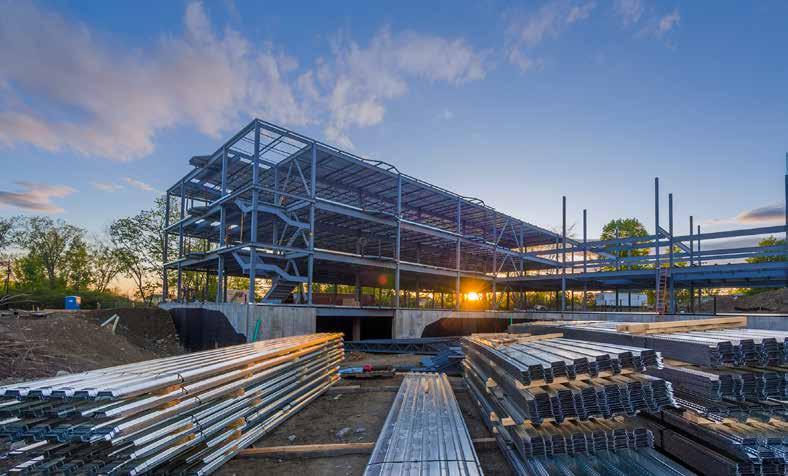
LET’S BUILD A SOLID FINANCIAL FOUNDATION.
LEGAL PERSPECTIVE
HOW “SURE” IS A SURETY BOND?
BY CHAD I. MICHAELSON AND ANDREW W. CLIFFORD
Surety bonds are one of the most common risk management tools used in construction. Owners and lenders ask for performance bonds to protect against contractor defaults, and payment bonds to protect against claims of nonpayment by lower-tier subcontractors and suppliers. But construction is complicated and disputes often arise over whether a default has occurred, or whether a subcontractor or supplier is entitled to payment. As a result, the road to recovery on a bond claim can be long and winding. Eastern Steel Constructors v. International Fidelity Insurance Company, a case recently decided by the Pennsylvania Superior Court, presents a cautionary tale.
The Project
In 2008, the Pennsylvania State University hired Ionadi Corporation to erect structural steel for a construction project, and Ionadi provided a payment bond issued by International Fidelity (IFIC). Ionadi subcontracted with Eastern to supply reinforcing steel. Halfway through the project, Ionadi stopped paying Eastern. In April of 2010, Eastern was owed $600,000 and made a claim against the payment bond. IFIC initially denied the claim, but later reversed course and made some payments to Eastern.
The Arbitration
At the end of the project, even after applying the payments received from IFIC, Eastern still was owed around $250,000. So Eastern filed for arbitration against Ionadi as required by its subcontract and invited IFIC to participate. IFIC declined, and Ionadi (which was basically out of business) refused to appear for the arbitration hearing. Eastern forged ahead, but on the day the hearing was to begin Ionadi filed for bankruptcy. Eastern obtained permission from the bankruptcy court to continue with the arbitration and, importantly, made sure IFIC had notice and an opportunity to participate in that proceeding. Eventually, the arbitrator found that Ionadi owed $433,000 to Eastern. This was comprised of the $250,000 subcontract balance, attorneys’ fees and costs of the arbitration, and interest at the rate of 18 percent as provided in the subcontract. Neither Ionadi nor IFIC sought to vacate the arbitration award or appeal the corresponding judgement entered by the Court of Common Pleas.
The Surety Lawsuit
IFIC refused to honor the result of arbitration so Eastern filed suit. Eastern claimed that IFIC had breached its obligations under the payment bond, and that its refusal to pay was frivolous and unfounded. The second claim was important, because Pennsylvania law makes an insurer that refuses to pay policy proceeds in bad faith liable for interest, attorneys’ fees and punitive damages. IFIC responded to the suit by arguing that it was not a party to the arbitration and was
not bound by the results. IFIC argued that Eastern should be required to re-prove, at a trial, that it was owed anything from Ionadi. IFIC also argued that Pennsylvania’s bad faith law only applies to insurance policies, not surety bonds, so Eastern should not be entitled to seek interest, attorneys’ fees or punitive damages in the case.
The litigation was vigorously contested. Eastern initially filed a motion asking the court to find that IFIC was bound by the arbitration award as a matter of law, and IFIC filed motions to the contrary. IFIC also argued that its obligations under the payment bond only extended to the cost of labor and materials supplied to the project, and not any interest, attorneys’ fees or costs due to Eastern under its subcontract with Ionadi. The court made rulings in favor of both parties, some of which appeared to be in conflict. It also gave IFIC permission to challenge one of those rulings before the Superior Court, delaying the progress of the case.
The court eventually scheduled a jury trial where Eastern would be required to re-prove its claims, but that trial was suspended while the parties continued to argue about what Eastern was entitled to recover and what evidence it would be allowed to present. At the end of the day, the trial court did not allow Eastern to present evidence that it had obtained a $433,000 arbitration award against Ionadi; to seek interest or attorneys’ fees due under the subcontract; or to pursue any of the additional damages available under Pennsylvania’s insurance bad faith law.
In February of 2020 – more than ten years after Ionadi had stopped paying Eastern, and eight and a half years after Eastern had filed suit against IFIC—a jury found IFIC responsible for the unpaid subcontract balance of $250,000. The court awarded legal interest (at 6 percent, rather than the 18 percent rate provided in the subcontract) that increased the verdict to $330,000. This was more than $100,000 less than the amount an arbitrator had ruled that Eastern was owed by Ionadi, and the language of the payment bond said that IFIC and Ionadi were equally responsible for any amounts due to Eastern under the subcontract. Eastern appealed this seemingly incongruous result, and in September of 2022 – now over twelve years removed from Ionadi’s initial payment default-the Superior Court issued an opinion that is instructive for surety companies and claimants alike.
The Result
First, the Superior Court held that IFIC was, in fact, bound by the arbitration award that Eastern had obtained against Ionadi in 2011. The payment bond put IFIC in Ionadi’s shoes and made it equally responsible for Ionadi’s obligations to Eastern under the subcontract. Ionadi’s failure to defend the arbitration was not significant to the Superior Court,
which held that IFIC was bound by the arbitration award against Eastern because IFIC had notice of and a reasonable opportunity to participate in the proceedings. Thus, the Superior Court concluded that the trial court should not have forced Eastern to re-prove its claims at a trial. Instead, it should have entered judgment in Eastern’s favor when the case was first filed.
Second, the Superior Court rejected IFIC’s claim that the bond only guaranteed payment for the value of labor and materials supplied by Eastern. The bond provided that IFIC was responsible for “all sums due” to Eastern under its subcontract with Ionadi, which included 18 percent interest on unpaid amounts and all costs incurred by Eastern in pursuing arbitration against Ionadi as required under the subcontract. Notably, the Superior Court held that Eastern was not entitled to costs incurred to pursue recovery from IFIC (or the higher rate of interest) because the subcontract clause was limited to litigation against Ionadi, and did not mention proceedings against its surety. As a result, Eastern was not entitled to recover any of the attorneys’ fees or costs it had incurred over the ten plus years it had spent litigating with IFIC.
Third, the Superior Court held that Pennsylvania’s bad faith law applied to claims against insurance policies, but not surety bond claims. Thus, the trial court was correct in preventing Eastern from seeking punitive damages or reimbursement of the fees and costs it had incurred to pursue IFIC.
Lessons
The presence of a fee-shifting provision (and an 18 percent interest rate) in Eastern’s subcontract—together with the language in the payment bond making IFIC responsible for “all sums due” to Eastern—had a powerful impact on this case, as it at least allowed Eastern to be made whole for its efforts to enforce its rights against Ionadi under the subcontract. At the same time, the absence of a contractual provision allowing recovery of costs incurred to pursue the surety forced Eastern to bear the entire cost of ten years of protracted litigation with IFIC. The penalties imposed on insurers for bad faith claims handling are intended to encourage good faith and fair dealing in the handling of insurance claims. Surety companies, however, are not subject to these penalties and do not have the same incentives.
The relationship between a surety company like IFIC, its principal (here, Ionadi) and bond claimants is a unique one, with many traps for the unwary. When faced with the prospect of making a claim against a surety bond (particularly when the principal is defunct or has chosen not to defend the underlying claim) it is important to consult with legal counsel to avoid mistakes that can jeopardize recovery. BG
Chad Michaelson is a partner at Meyer Unkovic & Scott LLP. He can be reached at cim@muslaw.com. Andrew Clifford is an associate in the construction practice at Meyer Unkovic & Scott LLP. He can be reached at awc@muslaw.com.


That’s why Peoples is committed to upgrading 3,000 miles of aging pipeline by 2034.
Every day we safely transport gas through 15,000 miles of pipelines (equivalent to the distance between Pittsburgh and Hong Kong)
As October 2023, we have replaced 1,000+ miles of aged Pipeline
The state-of-the-art upgrades help reduce Greenhouse Gas emissions.


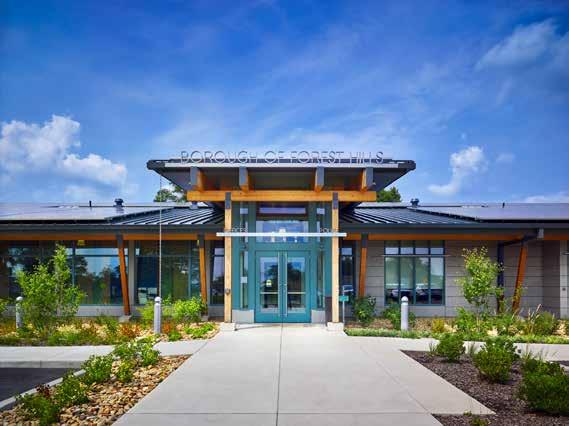
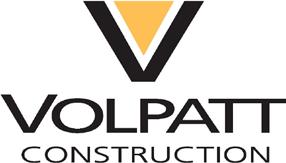
# W e A r e V o l p a t t ustrial institutional
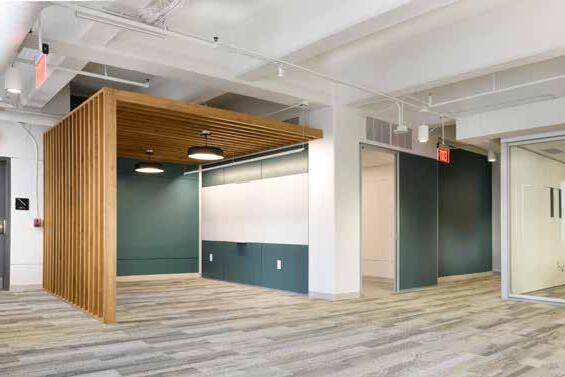
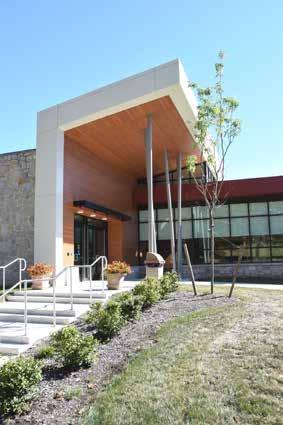



FIN ANCI AL PERSPECTIVE
CONSTRUCTION TALENT FOUNDATIONS
BY THEODORE M. PETTKO, CPA AND SHAD C. FAGERLAND, JD
In the post-COVID landscape, a noticeable shift due to talent shortages is that the evaluation process has evolved beyond being a mere interview procedure; it’s now a comprehensive recruitment endeavor. Candidates, having multiple employment options, assess you as much as you are evaluating them. Thus, the initial step in a strategic approach to talent is to ensure a strong foundation in your recruitment process.
This begins with meticulously crafted job descriptions for each role. For an outsider unfamiliar with your organization, these descriptions should unmistakably outline responsibilities, roles, and performance metrics. We recommend having existing employees draft written job descriptions for all positions. Subsequently, the hiring process should be more robust than simple job postings and interviews. This is your opportunity to impress candidates through effective organization, punctuality, and transparent communication. Implementing these seemingly basic steps can set you apart in the competitive landscape of recruitment.
The category “specified research or experimental expenditures” used in IRC Section 174 generally includes all costs incurred in the taxpayer’s trade or business related to the development or improvement of a product that would eliminate uncertainty concerning the development or improvement of a product.
Moving on from the hiring process, attention should shift to the onboarding procedure. Engage in discussions with recent hires to gain insights from their perspective regarding what aspects were advantageous and where the process fell short. Often, organizations maintain the same onboarding approach for an extended period. This phase presents another avenue to distinguish yourself in the recruitment process.
Finally, when it comes to compensation packages, they should encompass more than just a basic salary. Clearly delineate all offered benefits. An emerging trend includes incorporating deferred compensation or post-employment benefits into compensation packages.
Good employees are hard to find, particularly in the construction industry. If your business has struggled to attract and retain top talent, a nonqualified deferred compensation plan (“NQDC plan”) may be the tool you have been missing.
Compensation packages in the construction industry typically combine a relatively low rate of base pay with substantial project-based commissions or bonuses. While effective at rewarding productive employees upon completion of key projects, such compensation packages leave the door open to poaching by competitors once annual bonuses have been paid.
Adding a NQDC plan would enable the employer to introduce an additional element to the compensation package: time. For example, instead of offering a $50,000 annual cash bonus, a NQDC plan might offer a $200,000 cash bonus that is payable only if the employee remains with the employer for four years. Making a significant amount of compensation dependent on future services encourages retention and incentivizes employees to take the long-term financial success of the company into account.
A well-designed NQDC plan offers the following features and advantages:
• Participation can be limited to only a few key employees, with no requirement to offer similar benefits to the workforce at large.
• Any benefit amount is allowable, and benefits can differ from participant to participant.
• Benefit determinations can be discretionary; formulabased (for instance, a specified percentage of revenue or profits); or a combination of the two.
• Vesting provisions can extend as long as the employer desires. (Typical vesting schedules include a rolling fouryear vesting schedule applied to each annual benefit, or, for employers looking to encourage longer-term retention, a graded 10-year vesting schedule with the bulk of vesting delayed until the later years).
• Accelerated vesting and/or early payout can be provided in certain circumstances, such as death, disability or a change in control event.
• Benefits are not required to be pre-funded by the employer.
• Benefits are taxed to the employee and deductible by the employer in the year paid (i.e., not until after vesting).
A NQDC plan can also be designed to include “phantom equity” features that mimic the economic impact of business ownership. A phantom equity plan measures benefits not in terms of cash, but rather in terms of hypothetical shares that mirror the value of the enterprise or even the employee’s specific division. As the company grows, so does the value of the participant’s account. BG
Ted Pettko is a shareholder at Schneider Downs & Company. He can be reached at tpettko@schneiderdowns.com. Shad Fagerland is retirement solutions manager at Schneider Downs Wealth Management Advisors. He can be reached at sfagerland@schneiderdowns.com.
New Research and Development Capitalization Requirement Shuffles System
By Mark A. DiPietrantonio, CPA CCIFP
For tax years beginning before January 1, 2022, taxpayers could deduct research and experimental (R&E) costs in the year they were paid or incurred.
For years beginning after December 31, 2021, however, Internal Revenue Code (IRC) Section 174 requires those taxpayers to capitalize “specified R&E expenditures” (including any amount incurred in connection with the development of any software) and amortize the costs over the five-year period beginning with the midpoint of the tax year in which the expenditures are paid or incurred, essentially allowing the taxpayer to deduct 10 percent of the R&E expenses in Year 1.
A 15-year period (instead of the five-year) applies in the case of any specified R&E expenditures attributable to foreign research (IRC Section 174(a)(2)(B).
As an example, a calendar-year taxpayer typically pays $1,500,000 of specified R&E expenses in a tax year beginning after December 31, 2021. IRC Section 174 now requires that taxpayers amortize the amount paid ($1,500,000) over 60 months at $25,000 per month in Year 1. The amortization period begins at the midpoint of the tax year in which the expenses are paid or incurred (July), so the taxpayer’s deduction for the first year would be $150,000.
This new R&E capitalization requirement has surprised some taxpayers and resulted in a significant increase in their taxable income for 2022. In the example above, the taxpayer would have been allowed to deduct the entire $1,500,000 of R&E expenses in a tax year that begins before 2022, but for any tax year beginning after January 1, 2022, the taxpayer’s taxable income is $1,350,000 higher after capitalizing $1,500,000 of R&E expenses and subtracting $150,000 of amortization expense.
Costs Includible for Section 174 Treatment
A good starting point for determining which costs are required to be capitalized under IRC Section 174 is the “qualified research expenditures” that were used to calculate the R&E credit under IRC Section 41 as a conforming amendment to Code Sec. 41(d)(1)(A), which clarifies that after 2021, qualified research relates to R&E expenditures that are amortizable under IRC Section 174. Costs required to be capitalized
under IRC Section 174 are even more broad.
The category “specified research or experimental expenditures” used in IRC Section 174 generally includes all costs incurred in the taxpayer’s trade or business related to the development or improvement of a product that would eliminate uncertainty concerning the development or improvement of a product. This includes both direct and indirect costs of carrying out research or experimentation.
An example in the existing regulations – which have yet to be updated to reflect provisions of the current law – includes the following indirect and overhead costs as IRC Section 174 costs to the extent allocable to the research:
• Salaries
• Utilities (heat, light, power)
• Drawings and models
• Laboratory materials and other supplies related to research
• Depreciation of the building attributable to the project
Other costs also required to be capitalized under IRC Section 174 include:
• 100 percent of qualified contract research expenses, even though only 65 percent of these costs are permitted when calculating the R&E credit under IRC Section 41
Other indirect costs that may need to be capitalized under Section 174 include:
• Payroll taxes
• Employee benefits
• Indirect labor
• Rent
• Maintenance
• Insurance
The change from the ability to fully deduct R&E expenses to being required to capitalize is a change in method of accounting for tax purposes.
The capitalization requirement under IRC Section 174 will likely result in businesses allocating more of their operating cash to fund taxes for years beginning after 2021. It will be critical for taxpayers to consult with their advisors to comply with the requirements of IRC Section 174 and to implement other strategies to minimize their tax liabilities. BG
Mark DiPietrantonio is a shareholder at Schneider Downs. He can be reached at mdipietrantonio@schneiderdowns.com.






MANAGEMENT PERSPECTIVE
MANAGING THE EFFECT OF CONSTRUCTION INFLATION WILL BE EASIER IN 2024
Few challenges have been as great for owners, architects, and contractors since the pandemic as managing the cost of construction. After a wrenching three years, cost escalation eased in 2023, falling back to the historic two-to-four percent annual increase. For 2024, participants on both sides of the table can look forward to a full year of “normal” escalation assumptions for the first time since 2020.
Normal escalation is not deflation, however, and costs are not going to return to pre-pandemic levels. Estimates from a variety of sources put construction costs anywhere from 18 to 28 percent ahead of where they would be if the pre2020 trajectory had not been altered. For that reason, there is an obvious divide in the pipeline of proposed projects: those budgeted before 2022 and those budgeted since. For the former, progress will depend upon a significant increase in budget, a significant decrease in scope, or a significant change in the cost justification for the project.
There was rapid disinflation – the reduction in the rate of inflation – throughout 2023 for both consumers and businesses. By the end of 2023, the rate of consumer inflation, measured by the consumer price index (CPI), had fallen by nearly one-third from its summer 2022 high of nearly nine percent. Producer prices fell more precipitously, dropping to 1.3 percent year-over-year in November 2023, and deflating during the previous two months. The bellwether producer price index (PPI) for new nonresidential buildings (see below) fell to 0.6 percent year-over-year in October 2023 from a cyclical high of 24.1 percent in September 2022. Like the overall PPI, the index for new nonresidential buildings deflated as the year ended.
The difference between deflation and disinflation is what is causing discontent for consumers, who correctly perceive that prices in general are higher, even though inflation has fallen very close to pre-pandemic levels. Construction professionals better understand the difference between the two, or at least know that once inflation takes hold, there is little turning back. The lingering question as 2024 begins is, will the disinflationary trend continue? For the most part, the evidence is clear that it will.
Two countervailing forces will determine construction inflation in 2024. The more predictable force is the supply chain inflation. Less predictable will be market forces, which will impact both building product prices and final bid prices.
Accelerated inflation was a result of the demand for goods and services normalizing when vaccines for COVID-19 became widely available in spring 2021, long before the disrupted supply chain had normalized. In the U.S., this condition was exacerbated by the injection of money for consumers through the CARES Act of 2020, which included the Paycheck Protection Plan, and the American Recovery Plan of 2021. The impact of the federal funding abated by 2023 and the supply chain mostly normalized, but there are lingering factors that will be influential market forces for years to come.
The most influential of these is the labor shortage. Most businesses were challenged to find enough workers in 2019, even as the economy was slowing. Because demographics were the root cause of this, the intervening four years have exacerbated the problem. This tight labor market means that wages are higher, and productivity is lower, which adds costs to value-added products. So, while certain building materials may cost less now than a year ago, building products that are manufactured from those products may not. The steel market is an example of this phenomenon. The price of raw steel products is 25 percent lower than the May 2022 peak; however, the price of fabricated steel products is down less than five percent during the same period.
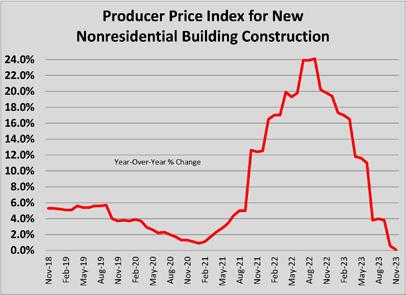
Source: Bureau of Labor Statistics, Federal Reserve Bank of St. Louis.
Demand for construction can also overpower declines in raw material prices. The price of #2 diesel fuel was 33 percent lower in November than a year ago, a trend that was driving the price of asphalt at the plant (which is derived from diesel) lower by 22 percent. Asphalt paving mixture prices were essentially flat year-over-year, however, and asphalt coatings and prepared asphalt-based roofing were more than three percent higher. Demand for infrastructure construction has driven the price
of finished asphalt-based products higher than the base material.
At the regional level, the other factor driving prices will be local competitive forces, including the availability of skilled labor. These factors will cause the greatest variation from region to region. Pittsburgh will not be a market where competitive forces or labor availability will be mitigating factors for inflation.
The majority of Pittsburgh’s nonresidential and commercial construction workers are union members. That means that most workers’ wage levels are established through long-term contracts. Depending upon when contracts are negotiated, wage rates can be higher or lower than the current market conditions dictate in times when there is higher volatility. In previous periods of higher inflation, there have been contracts that locked in rates that later were out of line with the marketplace. But, as 2024 begins, it appears that scenario did not unfold during the recent unusual period of escalation.

Source: Bureau of Labor Statistics, Federal Reserve Bank of St. Louis.
sort of diligence is helping to moderate escalation.
Dave Daquelente, executive director of the Master Builders’ Association of Western PA, which negotiates wage and benefit contracts on behalf of 35 general contractors, would not discuss the details of agreements with individual trades, but was willing to share that the agreements in place contained annual increases under four percent. All the agreements run through at least 2026, but not past 2027. That means a high degree of predictability about one significant factor in pricing during the coming two or three years.
“The contracts for the three trades we deal with expired at the end of May or June. Those are all locked in for at least three years. The plumbers, I believe, are five years,” says Jay Davis, president of SSM Industries. “The increases are in the four percent range. We are not building unusual escalation into our bids.”
“We agree. Pricing has leveled out now,” Jim Hyland, partner, and vice president of business development at Specified Systems Inc., a distributor, fabricator, and installer of windows, storefront, and curtain wall. Asked if customers are asking them to provide for escalation on long lead time projects, Hyland says, “It’s project dependent. It is definitely a conversation being had. If we’re asked, we are carrying three to five percent.”
Davis notes that there has been relief on the commodity side of procurement, although prices continue to vary. Indeed, the market price for copper tube is almost 18 percent lower and carbon steel pipe is eight percent lower than in November 2022. The price of sheet steel, however, is more than 27 percent higher.
Specialty contractors have been managing price volatility and availability since the recovery from the pandemic kicked into high gear in 2021. They are taking opportunities to substitute materials that are falling in price when feasible. Overall, that
“Escalation has slowed but we have certainly not seen prices return to pre-pandemic levels. We’re back to year over year levels that are typical,” says Todd Mikec, CEO of Lighthouse Electric. “There have been price decreases in some of the commodities. We are running aluminum conduit at the airport because when we did a bulk buy aluminum was cheaper, and the airport approved it. Now we’re back to shipping steel again because those prices have come down.”
The return to cost escalation that is predictable and modest is a relief for contractors and construction managers, most of which have been scrambling to try to meet clients’ budgets for three years. For now, contractors see less risk of budgetbusting inflation.
“Prices have stabilized. There are not the crazy price swings like there were in the last two years,” notes Brian Chlop, chief estimator for Burchick Construction.
“If an owner were to ask us now what kind of escalation we would need for a job that started next summer we would say in the three to four percent range,” says Ron Cortes, vice president of building operations at Mascaro. “That’s based on what’s happening in the market right now.”
Asked if he was concerned about or aware of any products or materials that were planning to implement price increases over the current trend, Cortes was cautiously optimistic.
“We have not heard or seen any drastic price increases being announced. Mascaro is a Butler Building rep. Butler announced a price increase for after the first of the year, but it was not abnormal, something in the couple percent range,” he says.
For their part, owners seem to be more cautious about the normalization of the supply chain and pricing.
“I think in many cases, we have seen a stabilization of the

market. However, we are still using a five percent escalation factor on proposed projects that won’t start until early 2025,” says Roger Altmeyer, vice president, construction,and project development for UPMC. “The lead times for major equipment is really the construction component that remains difficult to manage.”

565 Callery Road Cranberry Township, PA 16066 (724) 538-8227
Angela Wentz, Executive Director angie@asawpa.org
“We haven’t been actively pricing anything so it’s hard to compare apples to apples to judge how much escalation there has been. Prices continue to be higher than we think,” says Michael Barnard, chief operating officer at Oxford Development. “For what we forecast, we rely a lot on the construction manager to see what their suggestion is, based on the timing of the construction. We plug in an extra four or five percent per year.”
“Yes, we are seeing a return to ‘normal.’ We’re trying to gauge each year off trend lines, currently probably close to about three percent per year,” says Scott Bernotas, vice chancellor of facilities management at University of Pittsburgh.
The impact of disinflation appears to be bifurcating between public and private projects. While the prices of materials, products, and labor should not differ – Davis Bacon wage rates apply to virtually all public projects, regardless of whether the eventual contractor is union or not – there are differences that may explain why public projects have continued to come in dramatically over budget.
On publicly funded projects, the preconstruction process generally takes longer than is typical in the private sector.
Source: Bureau of Labor Statistics, Federal Reserve Bank of St. Louis.
Depending on the owner, public projects require public hearings, additional levels of approval, and generally more hands on the project than private projects. Bureaucracy and politics often slow public projects further. For even a small new public project, such as a municipal building or K-12 school addition, the length of time from when the project is proposed until it bids is two or three years. On larger projects, like the Airport Terminal Modernization Program, the process will consume half a decade before bidding occurs. That gives even modest inflation a lot of opportunity to impact the cost. When escalation is double digits, the effect is magnified. If there is a discernible trend in public construction escalation it is that projects that are bidding at prices that are closer to the budget are ones that have construction managers updating the budget more frequently.

Compared to the last dramatic spike in construction escalation, which occurred 40 years ago, the impact of the most recent bout of hyperinflation has been mild. In 1982-1983, construction activity declined precipitously. From 2021 to 2023, construction activity was essentially flat, adjusted for inflation. That meant roughly 10


percent of the projects in the pipeline did not get underway when expected. If construction escalation remains in its historical range going forward, expect activity to be more predictable through the middle of the decade BG
Designed and Built to Get Results
For more than a decade, DFL Legal has provided companies with the most effective solutions in resolving unique construction and engineering disputes.
Our success has been achieved by offering our clients proven, big case experience, along with the efficiencies and flexibility of a boutique firm.
Find out how our experience can be put to work for you.
Source: Bureau of Labor Statistics, Federal Reserve Bank of St. Louis.
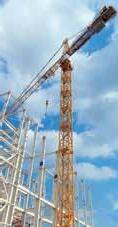








TREND TO WATCH
THE PITTSBURGH REGION’S REAL POPULATION CRISIS
BY KEN ZAPINSKI
Allegheny County and the entire Pittsburgh region is suffering from a population crisis that is unprecedented anywhere in the U.S., and how the community deals with it will have an impact for decades to come. There is a good chance that what you have read about the problem has not provided a clear understanding of its root causes.
Background: There is no place suffering from population decline in the United States quite like Allegheny County and the Pittsburgh region, according to a Pittsburgh Works analysis of census data. In the decades since the great industrial collapse and outmigration of the 1970s and 80s, the region has seemingly become desensitized to the issue. So much so that the unprecedented nature of our challenge has gone largely unnoticed.
The Pittsburgh region is an example of where much of the country is headed, with an aging population and migration flows to the South and the West. We have just arrived here sooner.
Chronic declining population can have an impact on the economy, government services, and quality of life. There is no model of how to deal successfully with the challenge. If the Pittsburgh region is to prosper in the future, we will have to discover the answer ourselves.
To understand the magnitude of the problem, we must start with the basics. Population change is driven by two components:
• How do annual births compare to annual deaths?
• How many people move into an area compared to how many leave?
Among the Top 50 metro regions, there was only one other where deaths outnumbered births in the decade: Buffalo, which suffered a gap of just 1,600.
Those numbers point to another trend unique to the Pittsburgh region: The shrinking of the outlying suburban/ rural counties.
There were three Top 50 markets where the central urban core county lost population in 2020: Cleveland (Cuyahoga), Detroit (Wayne), and Milwaukee (Milwaukee.) In each of those markets, nearly all the outlying counties grew during the decade, providing a buffer against the shrinking core.
Allegheny County does not have that luxury. Two-thirds of the outlying counties in the Pittsburgh MSA lost population between 2010 and 2020, with only Butler and Washington enjoying enough in-migration to offset their death rate.
But when the 2020 numbers came out, Allegheny County had gained population for the first time in 60 years. According to a Pittsburgh Works analysis of census data, rather than seeing a net decrease of 3,800 from people moving out, the county welcomed 35,000 net new arrivals, more than offsetting the number of deaths.
Among the country’s 50 largest metro regions, Pittsburgh is the only one with a central urban core county (Allegheny) where deaths outnumbered births between 2010 and 2020. This is a legacy of the outmigration of the 1970s and 1980s when families left the region looking for jobs. The children and grandchildren that otherwise would have been born here are instead living in Charlotte and Houston and elsewhere.
But the problem does not end at the Allegheny County border. Each of the other six counties in the metro regionl also experienced more deaths than births during the decade, a combination not seen anywhere else in the country.
Between 2010 and 2020, 42,000 more people died in the Pittsburgh region than were born, more than the combined populations of Uniontown, Greensburg, and Butler.
This is a phenomenon unlike anywhere else in the country. There are 358 outlying suburban/rural counties that are included as part of the 50 largest metro regions as defined by the federal Office of Management & Budget. Only 59 of them lost population during the decade.
Four of Pittsburgh’s six outlying counties landed on that list, and all of them were among the counties with the largest population loss.
The seven-county Pittsburgh region grew by 0.6 percent between 2010 and 2020, lagging far behind Pennsylvania’s 2.4 percent growth and the U.S. overall growth of 7.4 percent. It was the third-slowest rate among the Top 50 markets.
And if the most recent census estimates are to be believed, Pittsburgh is among the major metros that have lost population since 2020, alongside places such as Chicago, Cleveland, Detroit, Milwaukee, and Baltimore.
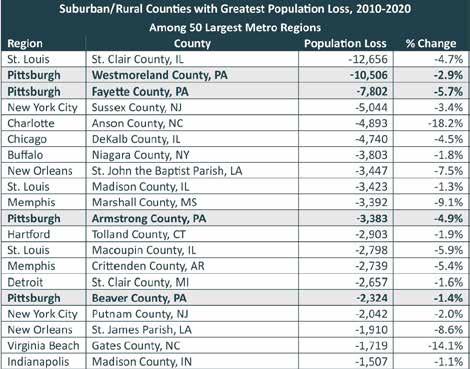
This list underscores the greatest challenge facing the Pittsburgh region: In each of those other places, all or most
of the population loss is from more people leaving than arriving.
If those shrinking places can find a way to convince people to stay by lowering taxes, or fighting crime, or offering more economic opportunity, or providing a better quality of life, they can reverse the trend.
In Pittsburgh, according to census estimates, 94 percent of the population loss is a result of people simply dying off.
Combating this demographic trend is far more difficult. You need to attract people, including younger people and families who in turn will raise children here.
Consider Detroit and Wayne County. Between 2010 and 2020, so many people left the county - more than 77,000 net decline - that the county would have shrunk by more than 4 percent. But because of the birth rate of the remaining residents, most of those departures were offset by new babies.
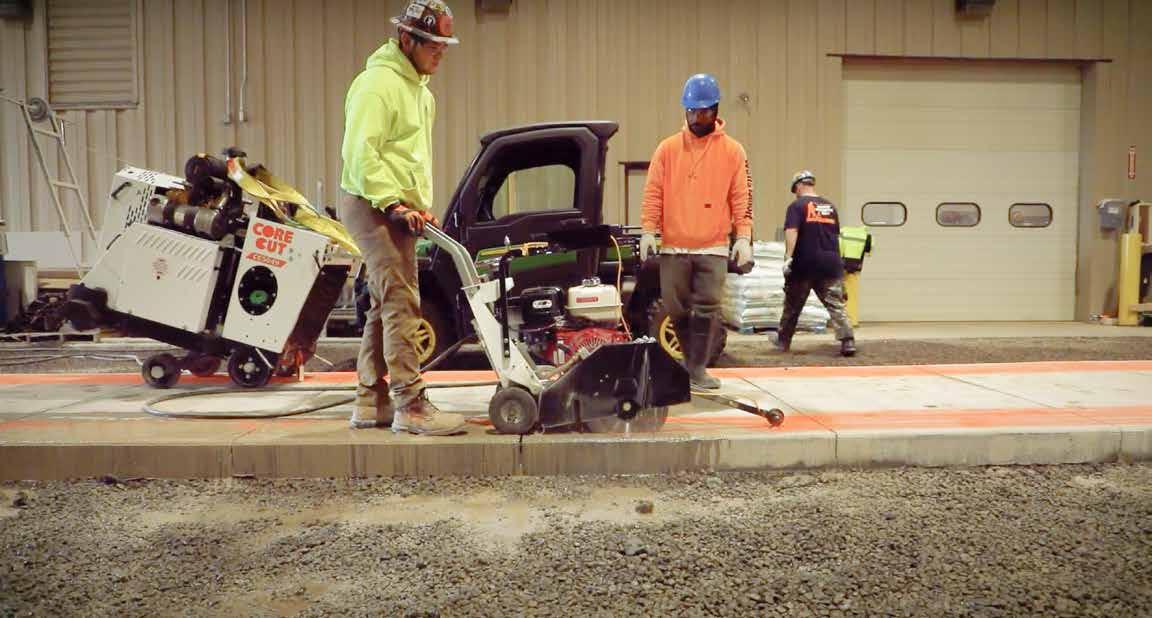


Contrast that to Westmoreland County. More people moved to the county than left in the last decade. But because of the overwhelming number of deaths, the county’s population shrunk by nearly 3 percent.
If there is one glimmer of hope, it’s possible that the current census estimates are not as bad as they appear to be.
In the years leading up to the 2020 Census, the Census Bureau estimated that Allegheny County had shrunk during the decade, not attracting enough new residents to offset the birth-death imbalance.
But when the 2020 numbers came out, Allegheny County had gained population for the first time in 60 years. 2
According to a Pittsburgh Works analysis of census data, rather than seeing a net decrease of 3,800 from people moving out, the county welcomed 35,000 net new arrivals, 3 more than offsetting the number of deaths.
Still, it’s impossible to ignore that Allegheny County and the Pittsburgh region face a uniquely challenging population crisis. If policy makers cannot reverse the trends, then they will have to develop plans to deal with a shrinking but aging population and a smaller economy.
No one has spent more time studying the region’s population trends and their significance than Chris Briem, a regional economist with Pitt’s Center for Social & Urban Research. Earlier this year, he recommended the book Shrinking Cities
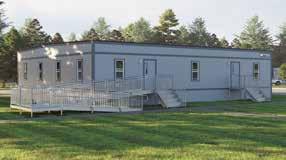
in a Shrinking World: Learning to Thrive Without Growth, by urban scholar Alan Mallach, as required reading for every public leader across Western PA. In the book’s introduction, Mallach lays out a challenge that should resonate with Pittsburgh’s regional leaders:
“I will explore what these forces mean for the future of shrinking cities in the United States and the challenges they will face. How will a country for which growth has always been central to its identity accept the reality of population loss, of becoming a smaller country?” BG
1 The seven-county Pittsburgh MSA as previously defined by the federal Office of Management & Budget (Allegheny, Armstrong, Beaver, Butler, Fayette, Washington, Westmoreland.} Lawrence County was added to the Pittsburgh MSA on July 1, 2023, but is not included in any of the “regional” analysis unless noted.
2 https://www.pghcitypaper.com/news/allegheny-county-gainspopulation-for-first-time-in-six-decades-says- census-20001909
3 The net migration numbers are determined by subtracting the birth-death (natural change} estimates for 2010-2020 from the population totals from the 2020 Census.
Ken Zapinski is director of research & public policy at Pittsburgh Works Together, a nonpartisan business-organized labor-workforce- economic development alliance working to grow jobs and expand the industries that are the foundation of our economy, including energy, manufacturing, and construction, to provide opportunity for all residents. He can be reached at ken@pghworks.com or 412-352-4364.
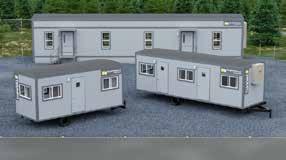
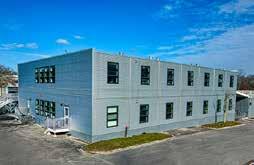

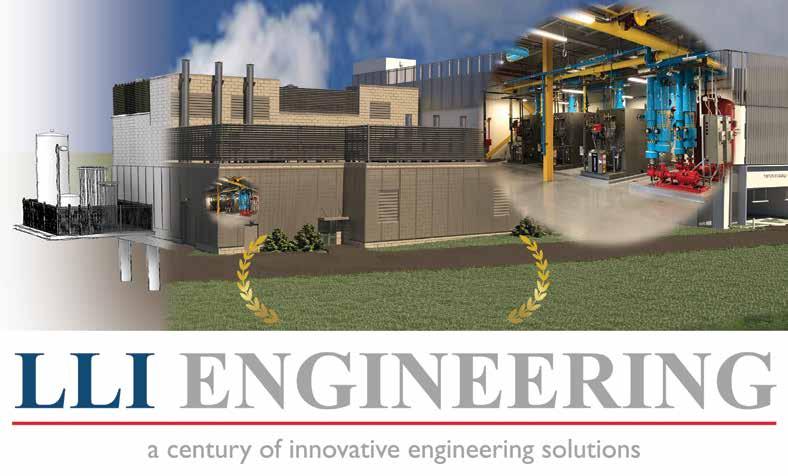


INDUSTRY & COMMUNITY NEWS
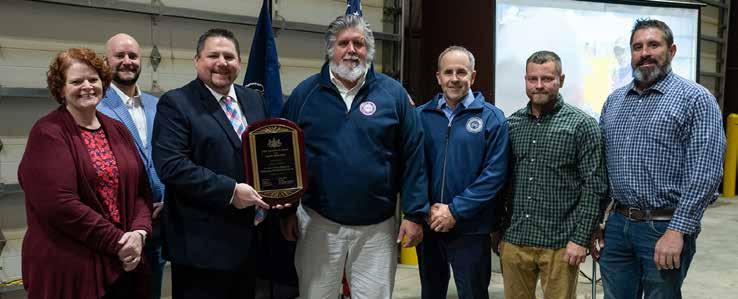
Independence Excavating received the 2023 Governor’s Award for Safety Excellence on November 22 for innovations that improved job safety. Independence Excavating specializes in heavy construction, demolition, industrial applications, environmental remediation, concrete paving, aggregate crushing, and recycling. The company employs 888 workers, including members of the International Union of Operating Engineers, Local Union 66; The Laborers District Council of Western Pennsylvania; United Brotherhood of Carpenters and Joiners of America, Local Union No. 441; and Cement Masons’ Local No. 526. Pictured from left are Marianne Saylor, director of the Bureau of Workers Compensation, Steve Yeckel safety director for Independence Excavating, Deputy Secretary for Compensation and Insurance Gerald Mullery, and Tom Melisko, Jesse DiRenna, Branden Lischner, and Gary Breidegam from Operating Engineers Local 66.
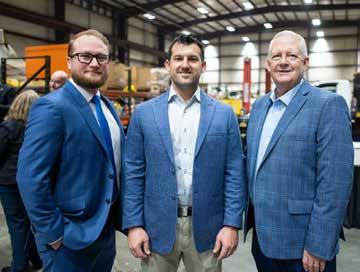

Mascaro raised over $16,000 at its Annual Guest Bartender event. John C. Mascaro, Jr. and Nate Martin worked the bar collecting tips to donate to the Cystic Fibrosis Foundation of Western Pennsylvania. Pictured are Mascaro and Martin with Sofia Martin (center).
Photo by Elliot Cramer Photo + Video.
(From left) MBA Executive Director Dave Daquelente, Michael Guarascio from Independence Excavating, and Bob McCall, safety director for the MBA at the Independence Excavating ceremony. Photo by Elliot Cramer Photo + Video.



Mascaro recognized Breast Cancer Awareness month through their annual Pink Day, raising funds this year for Pittsburgh Hearts of Steel.


Justin Jones from PJ Dick (left) and Heather Dolhi from Launch Entertainment.
Jendoco’s Michael Kuhn (left) and Mark Delanna from Genesis Partners at NAIOP Pittsburgh’s Night at the Fights on November 9.



(From left) Naley McKamish, Eric Pascucci from PJ Dick, and Dave Meuschke from Burchick Construction at the MBA Holiday Party hosted by the MBA’s Young Constructors on December 7. The event raised $9,000 for the Mario Lemieux Foundation/Austin’s Playroom.

Vernallis from Landau Building Co.
and TEDCO’s Kyra Sarver.



Avison Young creates real economic, social and environmental value as a global real estate advisor, powered by people. Our integrated talent realizes the full potential of real estate by using global intelligence platforms that provide clients with insights and advantage. Together, we can create healthy, productive workplaces for employees, cities that are centers for prosperity for their citizens, and built spaces and places that create a net benefit to the economy, the environment and the community.
(From left) Chris Young from PJ Dick, Jason Sigal from Sigal Development, and Desmone’s Tom Frank.
Jamison
(left)
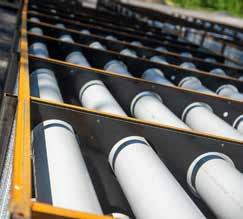
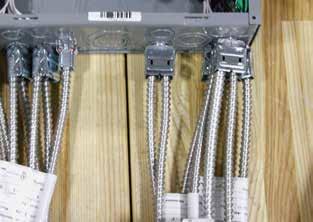
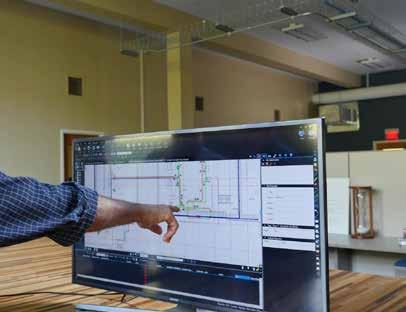








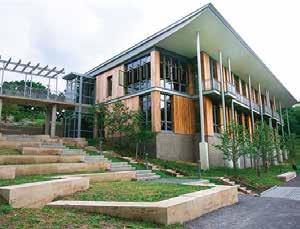

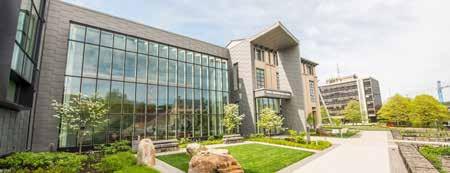

(From left) Rycon’s Paige Duncan, Lydia Fink, Miranda Anderson, Haley Loesch, Madison Blazer, Allison Early, and Paige Gillespie.
(From left) Zach Gumpher, Dave Gumpher Sr., Lori Gumpher, and Christian Gumpher from Gumpher Inc.
(From left) PJ Dick’s Nick Leonzio, Rehan Khan, Drishika Dugar, Raphael Ruggieri, and Brianne Kyle.


The MBA Holiday Party raised $9,000 for the Mario Lemieux Foundation/Austin’s Playroom. Pictured from left are Andrew Parish from the Mario Lemieux Foundation, Elliana Fry from the MBA, Brooke Waterkotte from Easley and Rivers, Shannon Construction’s Patrick Bruce, John Mascaro from Mascaro Construction, the MBA’s Mary Chuderewicz, and Austin’s Playroom Director Karin Girasek.


(From left) Jack Gurbacki from Bohler Engineering, Massaro Corporation’s Tara Ponitz, Anthony DiDiano, Jack Montgomery, Josh Hardaway, and Bobby Sullivan.
(From left) Sam Reihs, Sydney Zalewski, and Alex Nine from Mosites Construction.


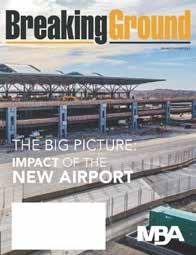



Nate Babyak from Providence Engineering (left) and Howard Solomon from Masonry Contractors’ Association of Western PA.
(From left) Jeff Young from Perkins Eastman, Mascaro’s Alyssa Kunselman, and Chris DiLorenzo from Turner Construction.
(From left) Chip Desmone, Reid Cservak from Rycon Construction, and A.J. Pantoni from Hanna Langholz Wilson Ellis at the NAIOP Pittsburgh holiday party.
We provide equipment rentals and water transfer services for the municipal, construction, manufacturing, and industrial sectors. Within our fleet, we carry Atlas Copco pumps, compressors, and generators. In addition, we carry temporary piping, filtration equipment, light plants, and heaters available to rent.
Our team at FieldForce can deliver solutions for complex water management projects, including temporary pipeline, specialized filtration, and maintenance events.
• Rapid response service
• Sewer bypass, dewatering, and water transfer
• Temporary pipelines
• WaterForceTM State-of-the-art controls and remote monitoring
• Emergency rentals available on a 24/7 basis
Visit FieldForceRentals.com, call 717-508-0550, or email Ask@FieldForceRentals.com to learn more or request a quote.
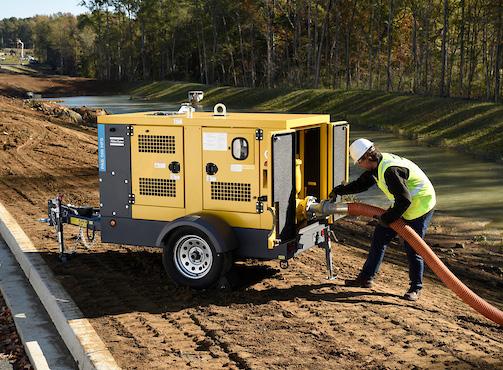
AWARDS & CONTRACTS
FMS Construction was awarded a $2.7 million contract for the general construction portion of the $3.6 million Center Township Municipal Building renovation. Lennon Smith Souleret is the project’s engineer.
Mercy Health-Youngstown and Lifepoint Behavioral Health selected Massaro Corporation as construction manager for its new $35 million Mercy Health Rehabilitation Hospital in Youngstown OH. The architect for the 72,000 square foot new facility is Stengel Hill Architecture.
Allegheny County Airport Authority awarded Massaro Corporation the $12,659,000 contract for the general construction portion of the $27.8 million Customs and Border Protection package for the Terminal Modernization Program. The architect for the 65,000 square foot facility is Gensler/HDR joint venture.
Massaro Corporation was the successful general contractor on the conversion of first floor of the former Oil City National Bank for the Venango County Economic Development Corporation. The architect for the $4.6 million renovation is DesignLAB Architects.
AIMS Construction was awarded the $2.8 Multi-Specialty Physicians Office Renovation at the St. Clair Professional Office Building at the St. Clair Hospital campus in Mt. Lebanon. The architect is MCF Architects.
University of Pittsburgh awarded AIMS Construction a contract for the Vice-Dean’s Suite Renovation, Scaife Hall Level 5. The architect is Moshier Studio.
AIMS Construction is the contractor for the Retail Cooler Replacement at UPMC Shadyside Hospital. AE Works LTD is the architect.
Carnegie Mellon University awarded AIMS Construction a contract for the Tepper School of Business Suite 4400 Renovation. The architect is Rothschild Doyno Collaborative.
Allegheny College selected the design-build team of Rothschild Doyno Collaborative and Mosites Construction for its multi-phase $15 million renovation of Reis Hall in Meadville, PA.
Pittsburgh Regional Transit awarded a $10 million contract to Mosites Construction for general trades construction for the West Mifflin Garage Equipment Replacement and Facilities Improvement. The $12 million project was designed by Whitman Requardt & Associates.
G. M. McCrossin Inc. was awarded a $4.9 million contract by Pittsburgh Water and Sewer Authority for the general/ mechanical construction for the Lanpher Reservoir Booster
Disinfection Improvements. Arcadis is the project’s engineer. In East Syracuse, NY, Rycon’s Special Projects Group is the general contractor responsible for converting a vacant 8,400 square foot retail space into a new $1.4 million cannabis dispensary.
Oxford Development Company chose Rycon’s Special Projects Group for the $1 million Design-Build fit-out for a 9,000 square foot Wine & Spirits location in Pittsburgh, PA.
Dick’s Sporting Goods selected Rycon’s Special Projects Group to renovate the 21,000 square foot Golf Galaxy store in San Diego, CA.
Rycon’s Special Projects Group is the construction manager responsible for the renovation of the fire alarm and sprinkler system at a warehouse for a medical device company in Murrysville, PA.
Rycon’s Special Projects Group is the general contractor building a $2.9 million, 3,700 square foot new Chase Bank building in Reynoldsburg, OH.
Starbucks selected Rycon’s Special Projects Group as the general contractor responsible for renovating two locations totaling over $1 million in Princeton, WV and Barboursville, WV.
In Pittsburgh, PA, Rycon’s Building Group is construction manager for the 56,000 square foot three-story vertical expansion on top of the existing mid-campus parking garage to expand and enhance Children’s Hospital’s cardiology program.
As part of the $1.4 billion Terminal Modernization Program at Pittsburgh International Airport, Rycon’s Building Group was the successful low bidder for the $7.9 million, 28,800 square foot airline fit-out package.
DiMarco Construction was awarded the general construction contract for the renovations to the Steel Center for Career and Technical Education in Jefferson Hills Borough. The architect for the $25.4 million project is HHSDR Architects & Engineers.
PJ Dick Inc. is the general contractor for the $20 million Penn Lincoln Apartments mixed-use development in Wilkinsburg, PA. The project includes 41 units of apartments and approximately 12,000 square feet of ground floor commercial space. The architect is Bohlin Cywinski Jackson.
PJ Dick is providing CM Agency services to Kiski Area School District for 100,000 square feet of comprehensive renovations to the Intermediate School.
PJ Dick is the CM at risk for construction of the 8,000 square foot Brady’s Run Educational Discovery Center, a state-of-the-art, hands-on learning facility designed to engage and educate the public community on recycling and environmental awareness.
Pittsburgh Water and Sewer Authority awarded PJ Dick the general construction contract for the new Highland Reservoir Pump Station. The project includes the construction of
a new pump station at the Highland Reservoir, including civil, structural, architectural, and mechanical work as well as work at the existing rising main gate house. Following completion of the new work, the existing pump station will be demolished.
The Citizens Science Lab selected A. Martini & Co. as general contractor for its $4 million Citizens Lab Renovation in the Hill District community of Pittsburgh. The architect is GBBN Architecture.


A. Martini & Co. was awarded the general construction contract for the new 70,000 square foot tenant fit out for the law firm of Dickie McCamey & Chilcote to be relocated to 4 Gateway Center. The architect is Perkin Eastman.
Shake Shack selected A. Martini & Co. to be the general contractor for their first location in Pittsburgh to be located at the Terminal Building in the Strip District. The $1.500,000 contract is for the 2,300 square foot fit-out. The architect is Bergmeyer.
A. Martini & Co. was awarded the interior renovation for the law firm of Weber Gallagher in 6 PPG on the 11th floor. This 5,000 square foot space was designed by Indovina Associates Architects.
Rob Roy Industries selected A. Martini & Co. to be its general contractor for the renovation of their offices located in Verona. Bridgette Pavlik is the interior designer for the space.
A. Martini & Co. was selected to be the general contractor for the façade renovation of the Neighborhood North - Children’s Museum of Play located in Beaver Falls. Draw Collective is the architect.
Veteran Leadership Program selected Dick Building Co. as general contractor for its $5 million renovation of the Good Shepherd School in Braddock, PA. AE Works is the architect for the adaptive re-use of the former school to transitional housing, career development, wellness programming, and other supportive service for veterans, as well as offices for Veterans Leadership Program.
Pittsburgh Water and Sewer Authority (PWSA) awarded a contract to Caliber Contracting Services for general construction on its $1.3 million security renovations at the PWSA main water treatment plant.
Landau Building Company is nearing completion on the second phase of the Grossing Station Lab Renovation at AHN’s Forbes Hospital. DRS Architects is the design professional.
Landau Building Company is working alongside CPL Architecture on the UPMC Hillman Cancer Center CT Replacement project at Heritage Valley Beaver Hospital.
Landau Building Company is serving as the general contractor for the Butler VA Health Care Center Infusion Clinic project. Oxford Development is the owner’s representative, and Stantec is the design professional. The project involves the interior renovation of a former childcare area and adjacent conference space to be converted into an infusion clinic.
Landau Building Company has started work on the 5,700 square foot office expansion project for SeqCenter, a life sciences company specializing in genetic sequencing services, located in RIDC’s The Chocolate Factory. NEXT architecture is the design professional.
Marks- Landau Construction was selected as the general contractor for the 7th Floor Progressive Care Unit Renovation at WVUM’s United Hospital Center. This project involves converting an existing behavioral health unit into an 18-patient bed progressive care unit, with Gresham Smith serving as the design professional.
The General Services Administration selected Burchick Construction as general contractor for the $26 million first phase of the Federal Courthouse Modernization in Clarksburg, WV. The project architect for the renovation of the 76,455 square foot historic courthouse is MTFA Architecture.
Shannon Construction is the construction manager-agency for the Commonwealth Charter Academy’s $15-20 million Monongahela facility. The architect for the renovation of 1200 Chess Street is Strada Architecture LLC.
Bethel Park School District awarded a $76.7 million contract to Rycon Construction for the general construction portion of its new $108 million elementary school. The architect is DRAW Collective.
Turner Construction was selected as general contractor for the tenant improvements for Federal Home Loan Bank at One Oxford Centre. The architect for the 50,000 square foot buildout is Perkins Eastman Architects.
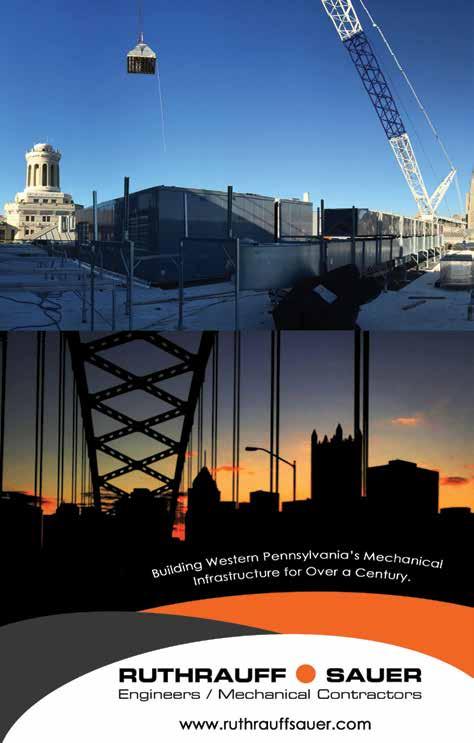


MICA members are interior contractors who share a common mission: to provide their customers with the highest quality craftsmanship. We partner with the union trades that supply the best trained, safest and most productive craftsmen in the industry.
Alliance Drywall Interiors, Inc.
Easley & Rivers, Inc.
Giffin Interior & Fixture, Inc.
JLJI Enterprises
J. J. Morris & Sons, Inc.
T. D. Patrinos Painting & Contracting Company
Precision Builders Inc.
RAM Acoustical Corporation
Schlaegle Design Build Associates
Wyatt Inc.
Pittsburgh Theological Seminary - Clifford E. Barbour Library Interiors contractor: Wyatt, Inc.
Another high quality MICA project
ContraCtors & Developers
look what
For over 100 years Local 66, in partnership with our employers, has been committed to providing qualified and competent Operating Engineers. For Local 66, meeting your short and long term employment needs is a priority.
The Operating Engineers lead the nation in pipeline training.
The best trained, most capable work force. Professional tradesman and tradeswomen have received the specialty training needed to meet the complex challenges of your project.
Services you can count on We’ll work with you to answer any questions or solve any problems at your convenience.
Smart business know-how. You’ll benefit from our years of experience and a proven track record we bring to the job.
Bottom-line dollar-for-dollar value. Value is bringing the highest professional and performance standards to your job site – from the beginning of a project to its completion. We at Local 66 are committed to being the premier value provider of Operating Engineers in the region.



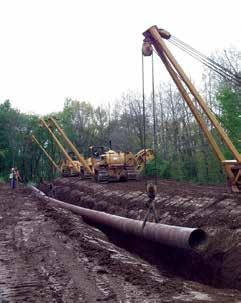


Photo by Craig Thompson Photography
FACES & NEW PLACES
Brandon Mendoza joined the Master Builders’ Association as its new director of public and government affairs. Mendoza most recently served as executive director of NAIOP Pittsburgh. He is a graduate of Lock Haven University and earned a master’s degree in public administration from the University of Pittsburgh.
AIMS Construction hired Brad Guenther as assistant superintendent.
On November 6, Ted Kartofilis joined Mascaro as construction quality control manager. He has over 30 years’ construction experience on bridges, buildings, and industrial facilities in capacities from field engineer to construction manager to vice president.
Dayton Biehl joined Mascaro as mechanical electrical plumbing coordinator on November 6. He has over 12 years of superintendent and project management experience.
Austin Patterson joined Mascaro as health safety and environmental manager on November 6. He has overseen work across Colorado, Pennsylvania, Ohio, Maryland, North Carolina, Virginia, and New Jersey.
Paige Gillespie, a York College of Pennsylvania alumna, has joined Rycon’s accounting department in Pittsburgh as accounts payable / accounts receivable.
Melissa Love, a Robert Morris alumna, has joined Rycon Pittsburgh’s accounting department as accounts payable.
Erin Hungerman joined PJ Dick family of companies as assistant equal employment opportunity (EEO) officer. Erin brings more than 15 years of experience working a similar role in higher education, specifically managing on-campus housing, student disciplinary processes, conducting policy violation investigations, and engaging in conflict management/mediation.
Justine McKloskey, was hired as receptionist/administrative assistant for the PJ Dick family of companies.
Preston Macready joined PJ Dick’s Construction Services Group – Metalfab division as an estimator/project manager. He graduated from University of Pittsburgh with a Bachelor of Science in engineering and has seven years of industry experience.
Jeff Stouden joined PJ Dick as a mechanical-electricalplumbing coordinator at the Terminal Modernization Program. He has previous experience working for a custom luxury home builder and regional contractors.
Allison Martini has joined A. Martini & Co. to fill the role of estimating administrator and assistant business development associate. Allison is a fourth generation Martini joining her family firm. Her previous position was as a sales representative located in Philadelphia. She earned a business management degree from the University of Alabama.
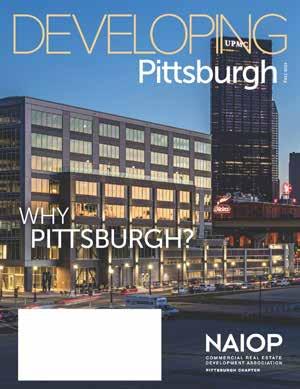



Megan Corrie has rejoined Turner as project preconstruction manager. Over her nearly fourteenyear career with Turner, she has held positions in both project management and procurement.
Andrew Cedillo has joined Turner as an engineering assistant and is working with its Interiors Department.
Tyrell Minniefield has joined Turner as an engineering assistant and is currently assigned to the Pittsburgh International Airport, Multi-Modal Complex project.
Joe Sager has joined Turner as an engineering assistant and is working in its Interiors Department.
Melissa Bonelli joined Massaro Corporation as a project engineer on October 31. Bonelli has been involved in project engineering and job site administration for more than a decade. She is a graduate of PennWest California with a degree in Industrial/Organizational Psychology.
Courtney Williams joined Massaro Corporation as a project manager in November. Williams has been a project manager working in commercial construction since 2011. She has a Bachelor of Engineering, Architectural Engineering degree from Penn State University.
Massaro Corporation announced that Kevin Vasil was hired as superintendent on October 17, 2023.
Brian Katanick joined Massaro Corporation as superintendent on October 31, 2023.
Wes Boggs joined Massaro Corporation on November 21, 2023, as warehouseman.
Massaro Construction Management Services announced that Matt Helm was hired as site manager in its State College, PA office on December 5, 2023. Helm is a graduate of Penn State University with a degree in Wildlife, Fish, and Wildlands Science and Management.
Massaro Corporation announced that P.R. Caracciolo joined the company as a project engineer. Caracciolo is a graduate of Mount Aloysius College.
Crissy Crovak joined Massaro Corporation as a project accountant.
Michael Baker International announced that John Robinson had joined the company as office executive for its Pittsburgh office. Robinson is a graduate of the University of Kansas. He earned an MBA from Carnegie Mellon University Tepper School of Business.
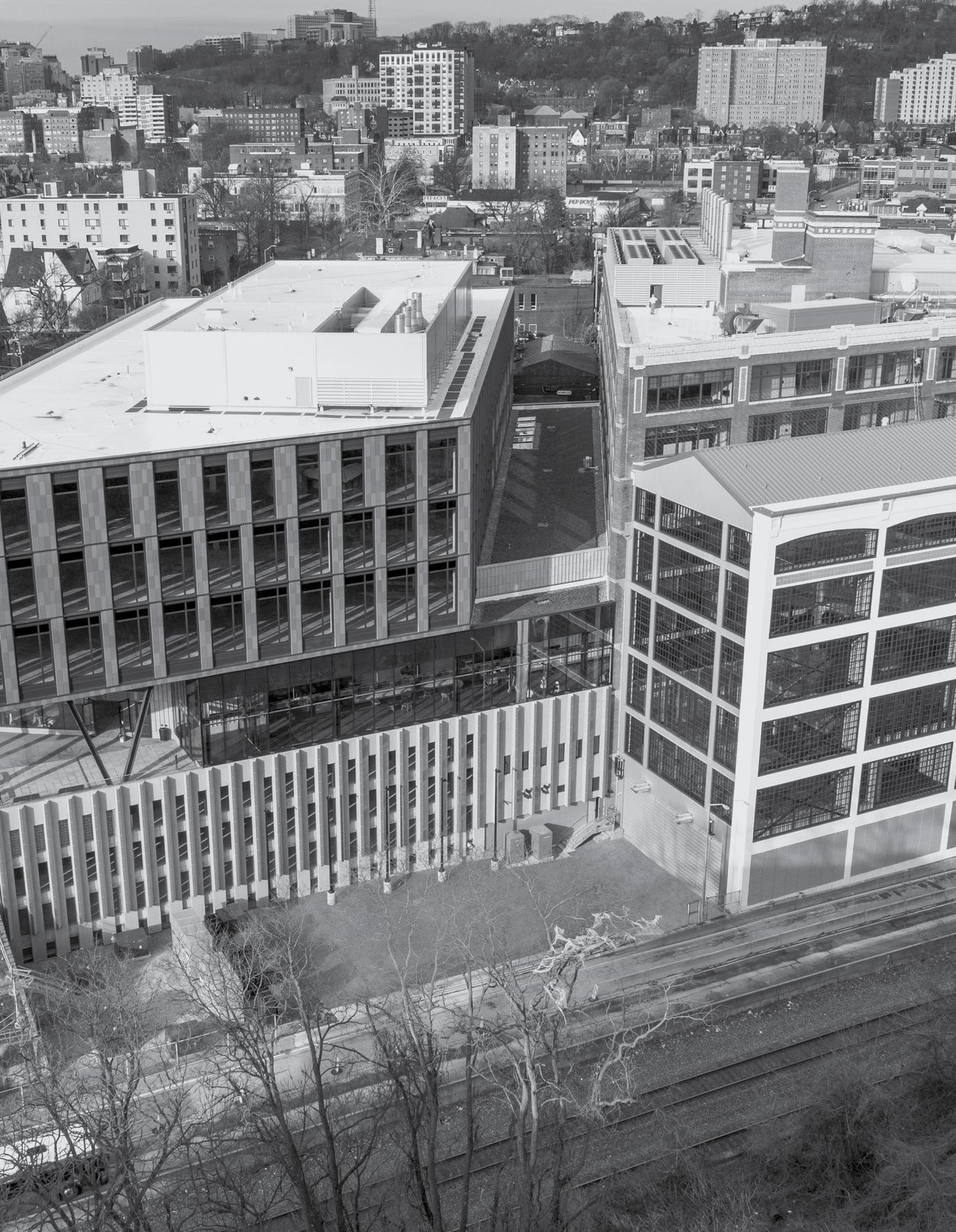
Acrisure Stadium, UPMC Club, 5–9 P.M. RSVP by February 15, 2024
Sponsorship opportunities also available. Learn more at info@mbawpa.org or call 412.922.3912. Register now at mbawpa.org
Pictured: 2022 Crystal Award Winner — The Assembly Contractor: Turner Construction Owner: Wexford Science & Technology Architects: ZGF Architects





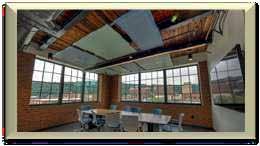

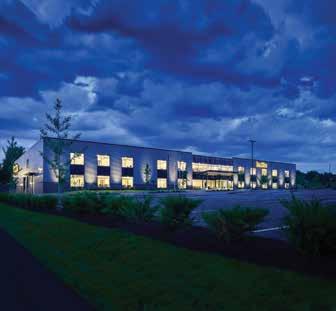

2023 MBA OFFICERS
President
Raymond A. Volpatt, Jr., P.E.
Volpatt Construction Corporation
Vice President and Treasurer
Michael R. Mascaro
Mascaro Construction Company, LP
Secretary/Executive Director
David D. Daquelente
2023 MBA BOARD OF DIRECTORS
John Paul Busse
F.J. Busse Company, Inc.
Alexander G. Dick
Dick Building Company
James T. Frantz
TEDCO Construction Corporation
Michael Kuhn
Jendoco Construction Corporation
Jeffrey C. Landau
Landau Building Company
Anthony F. Martini
A. Martini & Co.
Steven M. Massaro, Past President Massaro Corporation
David P. Meuschke
Burchick Construction Company, Inc.
M. Dean Mosites
Mosites Construction Company
Jake Ploeger
PJ Dick Incorporated
Jodi L. Rennie
Turner Construction Company
John W. Sabatos
Rycon Construction, Inc.
Fredrick T. Episcopo (MICA President)
Wyatt, Inc.
GENERAL CONTRACTORS
A. Martini & Co.
AIMS Construction
The Albert M. Higley Company, LLC
Allegheny Construction Group, Inc.
Burchick Construction Company, Inc.
Caliber Contracting Services, Inc.
Carl Walker Construction, Inc.
CH&D Enterprise, Inc.
Dick Building Company
DiMarco Construction Co., Inc.
E&G Development, Inc.
F.J. Busse Company, Inc.
Facility Support Services, LLC
FMS Construction Company
Fred L. Burns, Inc.
Independence Excavating, Inc.
Jendoco Construction Corporation
Kokosing Industrial Incorporated
Landau Building Company
Mascaro Construction Company, LP
Massaro Corporation
McCrossin
Menard USA
Mosites Construction Company
Nicholson Construction Company
PJ Dick Incorporated
Rocky Bleier Construction Group
Rycon Construction, Inc.
Shannon Construction Company
Spartan Construction Services, Inc.
Stevens Engineers & Constructors, Inc.
TEDCO Construction Corporation
Turner Construction Company
Uhl Construction Company
Volpatt Construction Corporation
MBA MEMBERSHIP
SPECIALTY CONTRACTORS
A Crane Rental, LLC
A. Folino Construction, Inc.
A. J. Vater & Company, Inc.
Abate Irwin, Inc.
ABMECH Acquisitions, LLC
ACE Lightning Protection Inc.
Advantage Steel & Construction, LLC
All Crane Rental of Pennsylvania, LLC
Alliance Drywall Interiors, Inc.
Amelie Construction & Supply, LLC
Amthor Steel, Inc.
Brayman Construction Corporation
Bristol Environmental, Inc.
Bruce-Merrilees Electric Co.
Bryan Construction, Inc.
Burke & Company, LLC dba S.P. McCarl & Company
Burnham Industrial Contractors, Inc.
Centerpoint Painting Systems, LLC.
Century Steel Erectors Co., LP
Clista Electric, Inc.
Cost Company
Costa Contracting, Inc.
Cuddy Roofing Company, Inc.
D-M Products, Inc.
Dagostino Electronic Services
Dom DeMarco Construction, Inc.
Donley’s Concrete Group
Douglass Pile Company, Inc.
Easley & Rivers, Inc.
EMCOR Services Scalise Industries
Fay, S&B USA Construction
Ferry Electric Company
Flooring Contractors of Pittsburgh
Franco Associates
G. Kidd, Inc.
Gaven Industries, Inc.
Giffin Interior & Fixture, Inc.
Gregori Construction, Inc.
Gumpher, Inc.
Gunning, Inc.
Geo. V. Hamilton, Inc.
Hanlon Electric Company
Harris Masonry, Inc.
Hatzel & Buehler, Inc.
HOFF Enterprises, Inc.
Howard Concrete Pumping, Inc.
Hunt Valley Environmental, LLC
J.J. Morris & Sons, Inc.
JLJI Enterprises, Inc.
Kalkreuth Roofing & Sheet Metal, Inc.
KELLER North America
Keystone Electrical Systems, Inc.
Kirby Electric, Inc.
Kusler Masonry, Inc.
L & E Concrete Pumping Inc.
Lanco Electric, Inc.
Lighthouse Electric Company, Inc.
Limbach Company, LLC
Lisanti Painting Company
Marsa, Inc.
Massaro Industries, Inc.
Master Woodcraft Corporation
Matcon Diamond, Inc.
Maxim Crane Works, LP
McCrossin Foundations, LLC
McKamish, Inc.
Mele & Mele & Sons, Inc.
Mohawk Construction & Supply, Inc.
NAES Power Contractors
Next 150 Construction, LLC
Noralco Corporation
Paramount Flooring Associates, Inc.
Phoenix Roofing, Inc.
Pittsburgh Interior Systems, Inc.
Precision Environmental Company
RAM Acoustical Corporation
Redstone Flooring, LLC
Renick Brothers Construction Co.
Richard Goettle, Inc.
Right Electric, Inc.
Ruthrauff | Sauer, LLC
Saint’s Painting Company, Inc.
Sargent Electric Company
Schindler Elevator
Schlaegle Design Build Associates, Inc.
Schnabel Foundation Company
Specified Systems, Inc.
Spectrum Environmental, Inc.
SSM Industries, Inc.
Swank Construction Company, LLC
T.D. Patrinos Painting & Contracting Company
TRE Construction
Tri-State Flooring, Inc.
W.G. Tomko, Inc.
W.O. Grubb Steel Erection, Inc.
Wayne Crouse, Inc.
Wright Commercial Floors
Wyatt, Incorporated
AFFILIATE MEMBERS
4CTechnologies
84 Lumber
ADMAR Construction Equipment and Supply
ADP
Aeropol LLC
AEC Online Store LLC
African American Chamber of Commerce of Western PA
Allegheny County Airport Authority–
Pittsburgh International Airport
Alliant
American Contractors Insurance Group
American Producers Supply Company
Amerisafe Group
AmeriServ Trust and Financial Services Company
A.R. Chambers & Son, Inc.
Assured Partners of PA, LLC
Atlantic Engineering Services
Atlas Marketing
Atlas Wholesale Co., Inc.
AUROS Group
Babst | Calland
Baker Tilly Virchow Krause, LLP
BDO USA, LLP
Beth-Hanover Supply Co., Inc.
Black Diamond Equipment Rental
Bowles Rice
Bronder & Company, P.C.
Building Point Ohio Valley
Burns & Scalo Real Estate Services, Inc.
Burns White, LLC
Cadnetics, Inc.
Case|Sabatini
CENTRIA
Chartwell Investment Partners
Chubb Group of Insurance Companies
Civil & Environmental Consultants, Inc.
Clark Hill PLC
Cleveland Brothers Equipment Co., Inc.
CliftonLarsonAllen LLP
Cohen, Seglias, Pallas, Greenhall & Furman PC
Computer Fellows, Inc.
Cozen O’Connor
Dentons Cohen & Grigsby P.C.
DesignGroup
Desmone Architects
Dickie, McCamey & Chilcote, P.C.
Dingess, Foster, Luciana, Davidson & Chleboski, LLP
Ditto
Dollar Bank
DRAW Collective Architecture
Eckert Seamans Cherin & Mellott
ECS Mid Atlantic, LLC
EPIC Insurance Brokers & Consultants
EquipmentShare
Fahringer, McCarty, Grey, Inc.
FDR Safety, LLC
FieldForce Equipment Sales & Rentals, LLC
First National Insurance Agency
Fisher Phillips
Frost Brown Todd, LLC
Gallaway Safety & Supply
The Gateway Engineers, Inc.
Graystone Consulting Pittsburgh Cleveland
Green Dot Active Solutions, Inc.
A.L. Harding & Company
H2R CPA
Henderson Brothers, Inc.
Henry Rossi & Co., LLP
HHSDR Architects/Engineers
Highway Equipment Company
Hillis Carnes Engineering Associates, Inc.
Huth Technologies LLC
Intertek - PSI
IMA Corp
J. S. Held
Karpinski Engineering
K&L Gates LLP
L & W Supply
LaFace & McGovern Associates, Inc.
Langan Engineering & Environmental Services
Liberty Insurance Agency
Liberty Mutual Surety
Lytle EAP Partners/Lytle Testing Services, Inc.
Maiello, Brungo & Maiello
Marthinsen & Salvitti Insurance Group
McKim & Creed, Inc.
McNees Wallace & Nurick, LLC
Meyer Unkovic & Scott, LLP
Meyers Company
Michael Baker International
Milwaukee Tool
Mobile Air, Inc.
Mobile Medical Corporation
Morgan, Lewis & Bockius LLP
MSA Safety
MSW Supply
Multivista
NCI - Nursing Corps
New Millennium Building Systems
NextEra Energy
Ohio Valley Drywall Supply
OVD Insurance
Philadelphia Insurance Companies
Pietragallo Gordon Alfano Bosick & Raspanti, LLP
Pittsburgh Mobile Concrete, Inc.
R.J. Bridges Corporation
Repco II
Republic Services, Inc.
Schneider Downs & Company, Inc.
Scotti Law Group
Seubert & Associates, Inc.
The Sherwin-Williams Co.
Sprague Energy
Stanley Black & Decker
Stephany Associates, Inc.
Steptoe & Johnson PLLC
Suburban Propane
Sunbelt Rentals, Inc.
Tarax Service Systems, Inc.
Tom Brown, Inc.
Travelers Bond & Financial Products
Triangle Fastener Corporation
Triumph Modular
Tucker Arensberg, P.C.
UBS Financial Services / The Sofranko Group
United Rentals, Inc.
UPMC Work Partners
USI Insurance Services
Werner Co
White Cap
WTW – Willis of Pennsylvania, Inc.
WNA Engineering, Inc.
Zurich NA Construction
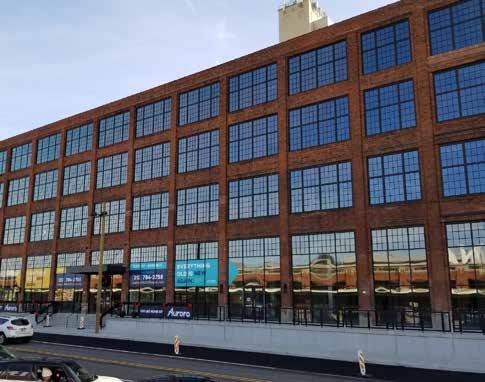
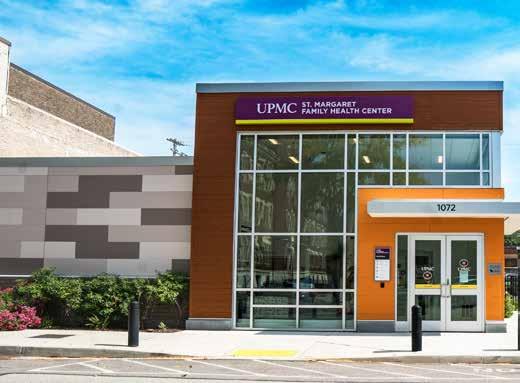




We are also committed to providing opportunity for all who share these
and want to pursue a
and satisfying career. For more information on building with our union trades and contractors, or to explore career opportunities, please visit www.buildersguild.org where you will find direct links to our Trade Unions, Joint Apprenticeship Training Centers and Contractor Associations.


CLOSING OUT
BY HONORABLE RICH FITZGERALD
People of a certain generation often ask, “Why are we building a new airport? Didn’t we just build one??
Well, it’s been over 30 years since we built the “new” airport. A lot has changed since then - including our region - immensely.
PIT as it is known, was built in the late 1980’s, exclusively for USAIR to be their hub. It was never built for the Pittsburgh traveler. That’s why parking, passenger drop-off, baggage claim, ticketing, and so many other amenities are inconvenient for all of us.
When we lost the hub, USAIR went away. PIT, which had been built for over 30 million passengers, was woefully oversized. At our lowest point, the airport was handling around 6 million passengers. While we are now up to about 10 million passengers with the new flights that airport director Christina Cassotis and her team have added (from 36 destinations to 62 at this time), we are still well short of that 30 million.
We also have a train, a baggage handling system, people movers, escalators, and other equipment that is over 30 years old and obsolete. Parts are no longer made to repair these items and much of the HVAC, electric systems, and other infrastructure systems are outdated. Because of that, there are often breakdowns leading to passenger delays, frustration, and a bad image for our region.
Christina Cassotis and her team embarked on a modernization program for the airport that not only improves the infrastructure, but will greatly enhance the passenger experience, both flying out and flying in. It will shorten the distance from parking or drop off to your gate, quicken the time to get your bags, and ease the process of renting a car, getting on the 28X, or getting a taxi or ride share. We’ll accomplish all this while also lowering the annual operating cost of airport operations.
The Terminal Modernization Project (TMP) is about improving the passenger experience while also having the ability to add more destinations and airlines, while also showing off great things about our region to people visiting PIT.
The TMP has also allowed the airport to provide workforce training for underserved individuals, giving them the skills to have a good paying career in the construction industry. PIT2Work has been so groundbreaking and innovative, we have had two White House visits by First Lady Jill Biden, Labor Secretary Su, and Transportation Secretary Buttigieg in the last few months to promote it to the rest of the nation. A key part of the PIT2Work program is the focus on removing barriers to employment for those participating
in the program. Recognizing the needs of PIT2Work participants, and airport employees, PIT has built an onsite childcare center. This effort was also lauded during the recent visit from the White House, and we’re thrilled that it is seen as a model for the nation.
The TMP builds on our sustainability efforts. We are the only airport in the country to produce our own energy, build our own cogeneration plant and be entirely off of the electrical grid, saving over $1 million per year. And we’re embracing technology to provide better indoor air quality, humidity and temperature control, disinfection of surfaces, ease TSA lines, and streamline other processes that are part of air travel.
These initiatives, and many others that there isn’t space or time to list, make this investment in our airport so important for this region.
And while this $1.5 billion investment in our region’s future is important to our local economy, the cost to the local and state taxpayer is zero. No local or state taxes are going towards this modernization. Instead, partnerships with our airline partners, the federal government, the foundation community, the corporate community, our labor union partners, and so many others have been coupled with the gas revenues at the airport to make this project possible.
When it opens early next year, Pittsburghers will be impressed. We will finally have an airport for us, built by us, that connects us to the nation and the world and that is worthy of the region we are becoming.
Rich Fitzgerald is the executive director of the Southwestern Pennsylvania Commission. He served as Allegheny County Executive for the past 12 years.

Rich Fitzgerald
EISLERADTOCOME

